

Top 10 CRM For Landscapers (Experts Choice)

10 Top CRM for Photographers | Updated (2024)

Netflix CRM Case Study: Their Secret Sauce 2024

10 CRM Case Studies From The World’s Biggest Brands in 2024

Tesla CRM Strategy: An Insider Blueprint Revealed (2024)

Walmart CRM Strategy: A Decade-Long Secret You Never Knew

Starbucks CRM Strategy (Everything Worth Knowing – 2024)

Amazon CRM Strategy: The Blueprint Behind The E-commerce Giant

How CRM is Evolving: Unlocking the Future of CRM Tools

5 Best CRM Software For Tour Operators & Travel Agencies in 2024

Mastering the CRM Selection Process: Your Ultimate Guide (2024)

Top 7 Best CRM For Event Management | Updated (2024)

Top CRM For Political Campaigns | Updated (2024)

Top 10 Best CRM For Outside Sales Reps | Updated (2024)

CRM VS SRM: What’s the difference?

Top 5 Best Solar CRM in Australia | Updated (2024)

State Farm CRM Case Study: Unveiling the Secrets and Myths

Top 5 Best CRM Software For Businesses in Singapore | Updated (2024)

Top 5 Best CRM Software For Distributors | Updated (2024)

5 Best Pharmaceutical CRM Software | Updated (2024)
- Case Studies
- Project Management
- Email Marketing
- Productivity
- Expense Management
- Artificial Intelligence
- BLOG & INSIGHTS
Case Study: 10 World-Famous CRM Implementation Failures
- Category : Case Studies
- Last updated on June 17, 2024
- By Ginika Anajulu
- No Comments
- Posted by Ginika Anajulu

CRM implementation failure rates are alarmingly high, nearing 90%, primarily due to companies misjudging their readiness for transition. One of the most notable CRM implementation failures was experienced by Hershey.
Hershey’s implementation plan, initially set for 48 months, was overly ambitious. Despite believing they were ready for the transition, they were caught off guard by the challenges, resulting in severe operational disruptions and a significant drop in their stock price.
To avoid such pitfalls, companies must thoroughly research and evaluate the best ways to integrate a CRM system with their existing customer interactions and workflows, ensuring alignment with their growth objectives.
This article discussed the world’s famous CRM implementation failure and preventive measures.
Reasons Why Most CRM Implementations Fail
- Focusing more on internal priorities than on customers’ needs is disastrous. Once you ignore customers’ needs, they will ignore your business, and failure will present itself.
- Lack of management from the business executives. Any business where the leaders are not fully engaged in CRM implementation would face failure.
- Rushing to implement CRM to enjoy credits offered by the CRM vendor leads to failure.
- Assumption kills; when you assume that a CRM software will perform a specific task without learning the features of the CRM can take that business to grave.
- Implementation missteps brought about by improperly staffed teams. The users of the CRM should be well-equipped with the CRM implementation processes.
- Complicated CRM software can be complicated for the CRM team to use. Ease-to-use CRM is the best to enable them easily understand the implementation processes.
Case Studies of CRM Implementation Failures
1. hershey's crm implementation failure.

The Hershey Company, commonly known as Hershey’s, is one of the largest chocolate manufacturers in the world.
In 2020, Hershey achieved its 100% certified and sustainable cocoa commitment in 2011. Despite being the world’s best chocolate manufacturer, Hershey encountered CRM failure in 1999.
- Their system testing failed.
- Its stock and quarterly profits dropped by 8% and 19%, respectively.
- Hershey’s could not process over $100 million worth of Kiss and Jolly Rancher orders, even though it had most of the inventory in stock.
Root Cause Of Hershey's CRM Implementation Failure
In 1996, Hershey decided to upgrade its legacy IT systems to an integrated ERP environment, incorporating SAP’s R/3 ERP software, Manugistics’ supply chain management (SCM) software, and Siebel’s customer relationship management (CRM) software.
Although the recommended implementation time for these platforms was 48 months, Hershey’s executives insisted on a 30-month turnaround to complete the rollout before Y2K. Additionally, they attempted to deploy all three technologies simultaneously, which was not ideal given the company’s operational readiness.
Compounding the issue, Hershey received the bulk of their holiday orders during one of their busiest sales and distribution periods. The new systems were not prepared to handle the surge, causing conflicts between various departments. The severity of the situation led to significant operational disruptions and a drastic plummet in their stock price.
Preventive Techniques
- Do not try to rush ERP system implementation to meet unrealistic timelines.
- Do not try to deploy a complex technology at once. Focusing on one centralized solution prevents minor problems from slipping through the cracks.
- Test the business processes and systems using a methodology to simulate realistic operating scenarios.
- Ensure you plan carefully and thoroughly when implementing complex technologies.
- Always Try to reduce incoming orders during the cutover period.
By adhering to these preventive measures, your company will mitigate failure risks and position itself to drive ERP success.
2. Vodafone's CRM Implementation failure
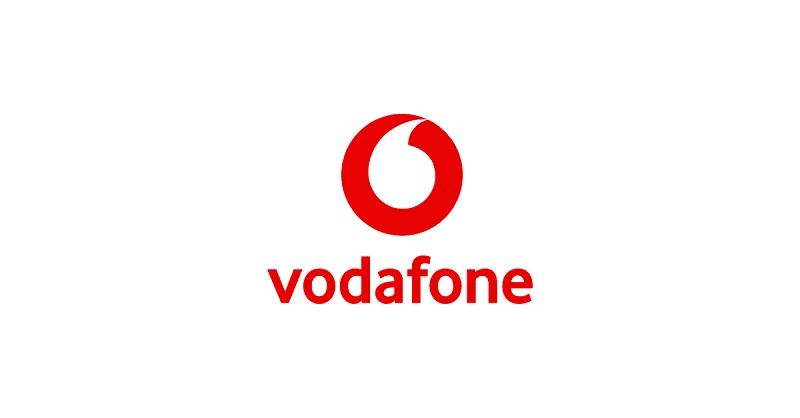
Vodafone is widely known to be one of the largest wireless phone companies in the world. They develop various products and services to help build future digital societies.
Despite their efforts to deliver a better customer experience, the following CRM failures caught them unawares:
- Error in customer billing data and price plans.
- Failure in customer support response.
- Massive Financial Losses
- Vodafone breached Ofcom’s billing rules.
Root Cause Of Vodafone's CRM Implementation Failure
In 2013, Vodafone experienced a significant financial loss due to a failed ERP implementation, costing the company millions.
The failure led to Vodafone breaching Ofcom’s billing rules. Firstly, their system failed to credit the accounts of customers who had paid for mobile credit top-ups, and they were slow to address the issue. Secondly, Vodafone failed to inform customers of their right to escalate unresolved complaints to a third-party resolution scheme after two months.
The new system’s failures caused a surge in customer complaints, prompting a formal investigation by Ofcom. Following the investigation, Ofcom fined Vodafone £4.6 million: £3.7 million for taking money from pay-as-you-go customers without providing the corresponding service, and £925,000 for mishandling customer complaints.
- Ensure you understand your company’s needs and how best to connect a CRM system with customers and workflows. CRM failure often occurs when a company invests in software that streamlines emails and text messages, but its customers prefer to communicate with them on the phone or in person.
- Quality data is necessary to realize the benefits of a CRM system. So, eliminate duplicates and correct inaccurate entries when combining databases or data sources.
- Equip your team with the knowledge and resources they need to respond to customers’ complaints correctly. You can still offer refresher courses for ongoing support even after formal training. You can also take advantage of training programs and learning opportunities, such as knowledge databases, offered directly by the CRM vendor. In the case of Vodafone, their representatives needed to be equipped with the resources and knowledge they needed to support their customers.
- Before starting the migration, consider using CRM software that integrates with your team’s other systems, like email, document sharing, marketing automation software, sales software, etc.
3. Blackberry's CRM Implementation Failure

Blackberry has been the most magnificent smartphone worldwide since the early 2000s. In the UK, It held over 55% of the smartphone market share in 2009, but its RIM disaster pushed it down to less than 4%. Blackberry has fallen victim to a botched CRM implementation, often with the following disastrous results:
- issues with its email services
- Messaging delay
- Browsing delay
- Poor customer support
Root Cause Of Blackberry's CRM Implementation Failure
“The service outage was caused by a core switch failure within RIM’s infrastructure; the system has a backup switch, but it failed to function as previously tested; we apologize for any inconvenience and are working to restore the normal service”.
– The company said in a statement.
The beginning of the end of Blackberry met them in 2010. BlackBerry has faded even further into the abyss to the extent that countless numbers of BlackBerry users have left Blackberry ever since then.
At that time, Most Blackberry users encountered slow or collapsed email services, browsing delays, etc, while BlackBerry Messenger also broke down.
Blackberry and their decision maker RIM-(Research in Motion), delayed explaining to their customers the cause of the service outage and when it would be resolved. They left their customers in the dark for some time. They neglected to use CRM software to send concise messages to their customers; instead, they relied on Facebook.
- Ensure you conduct quality checks on your service to know if it’s still in line with the current quality trends.
- Design a backup plan for your service and always test it. Blackberry designed a failover to backup switch, but the failover did not work as planned. So, you need to continuously evolve your backup strategy so that it responds whenever its needs arise.
- Being open and transparent in dialogue with your customers is the primary factor that helps in trouble times like this. It makes them believe in whatever you are saying.
- Do not delay giving them information about the problem and when it will be solved.
4. Cigna's CRM Implementation Failure

Cigna is a global health service company with the mission of helping people improve their health. Cigna has over 70,000 employees serving over 150 million customers throughout the world.
Due to their strong desire to deliver a better customer experience, they undertook a $ 1 billion initiative to overhaul their IT infrastructure and implement a CRM system in 2002. The CRM implementation did not work as expected, and the below failures sprang up immediately;
- $445 million net loss in 2002
- A drop in membership from 13.3 million to 12.5 million.
- Failure to access information about their coverage.
- Glitches in customer service
Root Cause Of Cigna's CRM Implementation Failure
Cigna embarked on a $1 billion initiative to move 3.5 million customers to a new system. The goal was to enhance productivity and reduce costs by replacing disparate legacy systems with a unified infrastructure.
Despite close monitoring by Chief Information Officer Andrae Anania, the project encountered significant issues. These challenges led to a massive revenue loss exceeding $400 million and caused widespread glitches in customer service, leaving millions of customers dissatisfied.
As a result, Cigna lost 6% of its healthcare members in 2002 alone.
- Take the time to follow best practices to reach CRM success carefully.
- Don’t expect the users to adapt to a new system in a short period quickly; take time to train and prepare them for the upcoming operational shifts.
- Hands-on training is essential for users to understand how to use a particular feature.
5. General Motors's CRM Implementation Failure

General Motors Acceptance Corp Commercial Mortgage(GMACCM) is the champion in business real-estate loans with a mortgage portfolio totaling more than $151 billion. In 1999, GMACCM began its own CRM initiative to increase automation, efficiency, and the amount of borrower information available to call center staff.
Unfortunately, the below problem surfaced;
- loan officers lost their business
- The rivals lured away their customers.
- 99% of its loan consumers zeroed out to a customer service operator.
- Multiple complaints from customers marred the company.
Root Cause Of General Motors's CRM Implementation Failure
The lack of user-centred design methodology is why GMACCM’s CRM implementations failed. They implemented a CRM solution without clearly defining the intended user’s needs. The CRM solution automated voice response technology as the first point of contact for consumers making loan inquiries.
They later discovered that 99% of its loan consumers were zeroing out to a customer service operator. Many complaints were coming from different customers, and loans lost a lot in their business.
- Ensure you always stick to customers care representatives to learn your customers’ challenges. GMACC should have continued using customer service agents to handle queries instead.
- The users of the system should be identified. User analysis, task analysis, and testing should have been employed.
- Consider conducting a simple user test as one of the CRM implementation strategies to know the user’s preferences. Had they conducted user tests, they would have discovered that many users would bypass their state-of-the-art system instead of talking to a live person.
6. BMC's CRM Implementation Failure

BMC Software, Inc. is one of the world’s largest developers and vendors of independent systems software. This $1.5 billion software company undertook an initiative for the implementation of CRM. They failed two times and succeeded on the third attempt. At the first attempt;
- They experienced very low utilization, with only 30 to 50% of users adopting it.
- They experienced the problem of inaccurate data.
They encountered the following problems on the second attempt;
- Failure to capture wide usage.
- The mistaken impression was that all the users needed to get on boarder more features and better data.
Root Cause Of BMC's CRM Implementation Failure
BMC was interested in the processes that they would perform faster without considering the needs of their customers. Methods and systems were implemented without involving the key executives. They assume that IT managers could handle CRM initiatives; that software would sell itself to employees and automatically generate the required organizational changes.
- If you rush into CRM implementation, you’ll run out of it. So, do not rush.
- Take your time to calculate your customer strategy, which helps employees understand where they are going.
- Equip your employees with the tools needed to succeed.
- Ensure you manage change effectively by showing support teams how to achieve their aim through new processes.
7. British Airways's CRM Implementation Failure

British Airways are well known for quality in-flight services and customer service. Their flight service covers more than 170 destinations worldwide whilst supporting the UK economy by providing vital channels for trade and investment. British Airways have a long history of CRM failure.
- The data structure wasn’t designed for analytical purposes, so it was difficult for the analytical team to understand the system.
- Creating queries was slow and complicated, even for the most straightforward generation.
- A lot of time is consumed in training the SAS users.
- The analytical team’s confidence was undermined due to many questions regarding data quality.
Root Cause Of British Airway's CRM Implementation Failure
British Airways undertook an initiative in 2001 intending to simplify the decision-making processes. The initiative was to consolidate information from the organization into its Integrated Commercial Warehouse. They adopted Ocean Wave, also known as Customer Data Warehouse, as the CRM. The analytical finds it challenging to understand because it wasn’t designed for analytical purposes. They experienced failures, and the CRM implementation took them two years to complete.
- Take your time to assess the company’s needs because most CRM failures have more to do with how the company views itself than the system’s ability.
- Companies should concentrate on CRMs that are Simple and training-rich; so team members can use CRM easily and quickly when tasks are automated.
8. Owen Corning's CRM Implementation failure

Owen Corning is the world’s largest manufacturer of fiberglass composites. They claimed to be the global leader in residential, commercial, and industrial building materials, including insulation and roofing products. But the following CRM failures slapped them in 1992.
- They were unable to boost the customer service of their current customers.
- Unable to create fresh interactions with potential clients.
- They experienced the draining of a large chunk of the budget.
Root Cause Of Owens Corning's CRM Implementation Failure
The primary reason why Owens Corning failed in its CRM implementation was that it neglected customers’ preferences. They decided to adopt a CRM tool in 1992 due to a lack of consistency in marketing across different departments.
The CRM team found it challenging to integrate the new system because the company was busy updating its internal processes using an extensive ERP system.
This took away the attention of the representatives from the CRM integration, and customer service was not taken care of.
Prevention Techniques
- Owen Corning should have taken the customers’ needs as the main priority and worked backwards from that point.
9. Dow Chemical's CRM Implementation Failure

Dow Chemical is among the three largest chemical producers in the world. With a presence in about 160 countries, it employs approximately 37,800 people worldwide.
In a bid to update customer support, they undertook a CRM initiative but experienced failures in the process:
- Inadequate definition of business processes.
- Failure to support users
Root Cause Of Dow Chemical's CRM Implementation Failure
Dow Chemical rolled out an extensive, overly complex CRM in 1992. This overly-complex CRM initiative failed due to an inadequate definition of the business processes. It was unable to provide remote support for the users. Later, an attempt at implementing a smaller, more localized CRM initiative was successful. It allowed the company to address more specific issues and scale down the number of projects allowed.
They should have clearly defined the overall business processes for better CRM implementation.
10. CarsDirect's CRM Implementation Failure
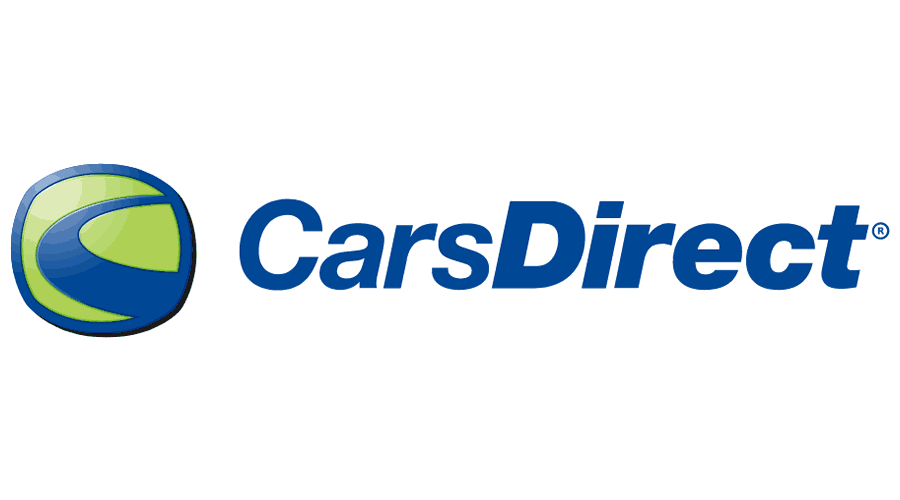
CarsDirect.com is a leader in the online automotive space. They have been in the business of helping people buy cars for over 12 years now. They suffered the following failures after implementing a customer tracking tool;
- $50 million in operational losses
- Failure to achieve a return on investments
- Budget overruns
- Customer confusion, frustration, and dissatisfaction.
- High post-implementation running costs
To prevent this kind of failure, the best option is to use a scalable and robust CRM tools that accomodates the growth of the company. For instance, Salesforce and Hubspot .
Conclusions
CRM implementation is a complex process that requires careful planning and execution. Unfortunately, the failure rate of CRM implementation is high, with some studies suggesting it is as high as 90%.
This article explores some of the most famous CRM implementation failures, including those experienced by Hershey, Vodafone, Blackberry, Cigna, General Motors, British Airways, Owen Corning, Dow Chemical, and CarsDirect. The root causes of these failures are analyzed, and preventive measures are presented to help companies mitigate failure risks and position themselves for successful CRM implementation.
Choosing easy-to-use software and taking time to understand the best practices are crucial to a successful CRM implementation.

Ginika Anajulu
Ginika is a passionate content writer who is interested in SEO Digital Marketing. When she is not working, she dives into the world of cooking.
Leave a Reply Cancel reply
Your email address will not be published. Required fields are marked *
Save my name, email, and website in this browser for the next time I comment.
Related Posts

Coca-Cola CRM Case Study: The Untold Story
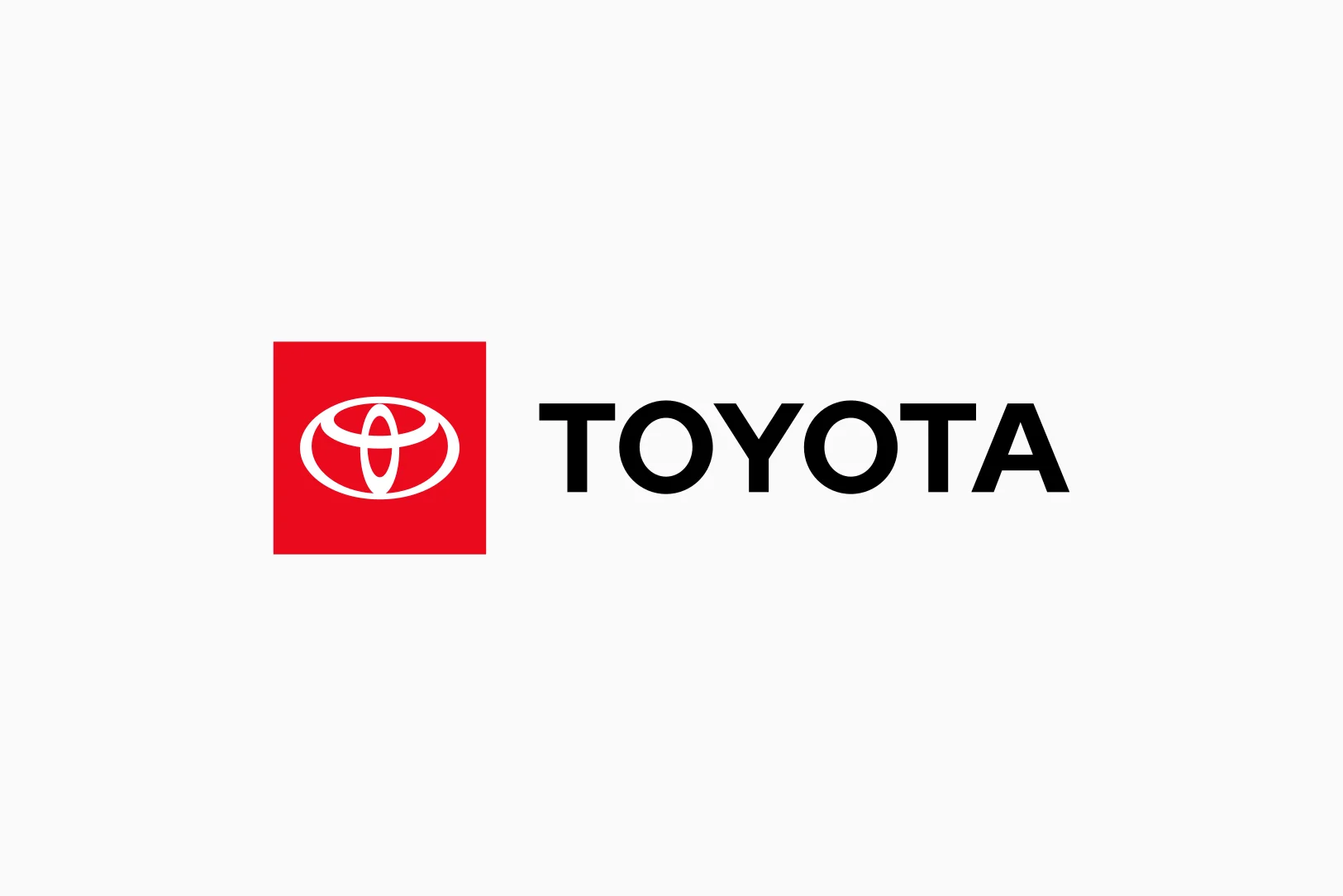
Toyota CRM Case Study: Unveiling the Secret Strategy

Employ in 150+ Countries Within Hours Without Breaking the Bank.
Table of Contents
About crmside.
CRMside is an online resource publication that focuses on CRM case studies, guides, product reviews, and expert tips, aimed at providing our readers with valuable insights and strategies to help maximize their CRM solutions and achieve business growth.
- Privacy Policy
- Terms of Use
NAVIGATIONS
- A Hub For CRM Resources
- Affiliate Disclaimer
© 2024 CRMSIDE.COM ALL RIGHTS RESERVED.
- BROWSE CRMs
- SUGGESTED TOPICS
- The Magazine
- Newsletters
- Managing Yourself
- Managing Teams
- Work-life Balance
- The Big Idea
- Data & Visuals
- Reading Lists
- Case Selections
- HBR Learning
- Topic Feeds
- Account Settings
- Email Preferences
Why CRM Projects Fail and How to Make Them More Successful
- Scott Edinger

Use them to improve the sales process, not just evaluate it.
The primary reason CRM systems miss the mark in helping companies increase revenue is because they are too often used for inspection, rather than creating improvement in the sales process. Front-line sales professionals and managers rarely find the majority of these capabilities useful in winning more business for the company. If you want your CRM implementation to increase revenue, you have to re-think your CRM as a tool to do so. That is why you invested in its deployment. Also, integrate your marketing efforts with sales activity. This kind of integration, using your CRM as the glue, will improve marketing’s efforts to create gravity with prospects, and sales’ ability to accelerate sales cycles. Lastly, sales managers must use it as a tool to jointly create strategies for major opportunities, and help the sales team to maximize opportunities by coaching them throughout the sales process.
In 2017, CIO magazine reported that around one-third of all customer relationship management (CRM) projects fail. That was actually an average of a dozen analyst reports. The numbers ranged from 18% to 69%. Those failures can mean a lot of things — over-budget, data integrity issues, technology limitations, and so forth. But in my work with clients, when I ask executives if the CRM system is helping their business to grow, the failure rate is closer to 90%.
Partner Center
The 2024 Top 10 ERP Systems Report
Our experts have highlighted ten vendors that can help your organization make data-driven decisions.
The 2024 ERP Report
Every year, Panorama analyzes industry trends to understand organizations’ selection and implementation practices when it comes to enterprise software.
ERP selection & implementation
Management consulting
Software Expert Witness
The 2024 Top Government ERP Systems Report
This independent report highlights the ERP vendors that Panorama has found to be highly functional for states, municipalities, nonprofits, and other public sector entities.
Reports & Whitepapers
Tools & Resources
Events, Webinars & Podcasts
ERP Consultations
Popular Blogs
Top 10 ERP Software
Our list of top 10 ERP software highlights the vendors our ERP experts have found to be innovative and strong in functionality. This is an overview of those ERP systems.
Blog Collection
Lessons Learned from the Vodafone CRM Failure
by Bill Baumann | Feb 24, 2021

One of the top, multinational telecommunications companies, Vodafone, is used to being in the news. However, in 2016, the company made a different kind of headline.
That year, Vodafone was hit with what was recognized as the single-biggest fine ever imposed in the UK for “serious and sustained” breaches of the country’s ironclad consumer protection rules. Costing £4.6 million, the fine was the direct result of a failed attempt to centralize the company’s operations with an extensive CRM and billing migration program.
What led to the Vodafone CRM failure and what lessons can we take from it? Today, we’re sharing how to avoid the same fate during your own CRM implementation.
A Large Governmental Entity's Failed Implementation
Panorama’s Expert Witness team was retained to provide a forensic analysis and written report to the court regarding the failed implementation of a major software developer’s ERP/payroll system.
The Vodafone CRM Failure: What Happened?
The project was hefty, but it started out promising enough.
In 2013, Vodafone began an extensive effort to migrate and consolidate all its billing and CRM systems onto a single Siebel platform. This was the largest IT effort the company had ever undertaken, and it required moving over 28.5 million individual customer accounts. At the time, those accounts were spread among a whopping seven different billing platforms.
It didn’t take long for the problems to begin snowballing. As the migration effort went into full swing, Vodafone reported that a “small proportion” of the accounts were migrated incorrectly.
These data migration errors caused the following problems:
1. Customer Billing Errors
The company incorrectly entered and stored records in the new CRM system. This led to mistakes in customer billing data and price plans.
More specifically, nearly 10,500 pay-as-you-go customers lost money when they paid to “top-up” their mobile phone credit, but Vodafone failed to apply this credit to their accounts. Over the 17 months that the IT failure occurred, these customers were out a collective £150,000.
When Ofcom, the U.K.’s telecommunications regulator, learned of the error, they issued two fines to Vodafone. The first was £3.7 for taking money from pay-as-you-go customers without delivering a service in return. The other was £925,000, issued for Vodafone’s inadequate customer support response.
2. Massive Financial Losses
By 2015, Vodafone admitted to the breaches and compensated all identified customers who were affected by the issue. Still, the failure resulted in a major financial setback, along with a bruise to the Vodafone brand.
3 Lessons Learned from This CRM Failure
If you’re on the cusp of a CRM project, what can you learn from these two years of turmoil? Let’s take a look at three lessons learned from the Vodafone CRM failure and how you can avoid them in your own organization.
1. Be Open to Business Process Reengineering
The most sophisticated CRM system in the world won’t deliver on expected benefits if your company holds tight to an outdated and inefficient customer service model.
In the case of Vodafone, the company was already recognized as lagging in this department. In fact, according to a market survey conducted by Ofcom in 2015, Vodafone easily took top honors as the “most complained about” UK mobile provider. While most companies fielded around 10 complaints per 100,000 customers, it had nearly three times that amount.
Still, it pressed forward with a CRM implementation without addressing those areas of weakness. As a result, when the migration failure occurred, representatives were ill-equipped with the resources and knowledge they needed to correctly respond to customer complaints.
If your processes are as broken as Vodafone’s, you may want to conduct business process reengineering before your implementation begins. Start by determining which workflows are already optimized and which need tweaking. Don’t be afraid to shed practices that are no longer serving the customer.
2. Invest in Employee Training
In a statement acknowledging the CRM failure, a Vodafone representative said the company planned to invest an additional £30m in its customer service department. This included more than 190,000 hours of representative training to ensure employees knew how to identify and resolve customer problems.
While the effort is a valiant one, it can be considered too little, too late. Proactive employee training on how to effectively use and manage the new CRM system would have been preferable to a late-term response.
End-user training is an essential part of organizational change management and ensures that everyone in your workforce knows exactly how to use new software, whether this is ERP software , HCM software or CRM software.
In a CRM implementation, training not only mitigates change resistance, but it also empowers your staff to use the features correctly when responding to customer requests.
3. Include Issue Resolution in Your Project Plan
There are bound to be a few hiccups in any CRM implementation. However, a proactive approach to issue resolution can keep issues from having a detrimental domino effect.
A clear and thorough project plan can help you identify potential risks before they even occur. From there, you can determine the steps to take to mitigate and contain these risks.
Had Vodafone followed this model, they could have spotted and flagged the customer account missteps much sooner. Instead, the company noted the teams responsible for managing the relevant areas did not identify issues “fast enough.” Once they did catch wind of them, they “did not fully appreciate” the significance they carried.
Within your CRM project plan, we recommend defining internal controls and escalation procedures. This way, everyone knows exactly what to do at the first sign of a problem.
Expert Support for Your CRM Implementation
The Vodafone CRM failure was a master study in a lack of preparedness. Not only were support representatives ill-equipped for the wave of customer complaints, but the new platform itself was faulty from the beginning due to the botched migration.
Add in lethargic internal controls and a lack of risk management, and it’s easy to guess what happened next.
Our team of ERP consultants can help you avoid these issues and set your CRM implementation up for success from Day One. Contact us below to learn how.

Posts You May Like:

The Detrimental Impact of Legacy Systems on IT Modernization
Digital transformation has evolved from a buzzword to a critical strategy for enabling data-driven operations. Yet, for many organizations, the journey toward digital transformation is hindered by outdated software and legacy systems. Today, we’re talking about the...

What Does ERP Actually Do? (9 ERP Functions You Should Know)
If you’re just beginning to learn about enterprise resource planning (ERP) software, you may have found that a clear definition can be hard to find. Instead of vague quips about its data integration benefits and its process optimization possibilities, you need the...
Privacy Overview

Saturday, May 30, 2020
- Labels: Case Studies , Project Failure
Case Study 13: Vodafone's £59 Million Customer Relationship Disaster

Is your project headed for trouble? Find out! Just answer the 27 questions of my Project Trouble Assessment , which will take you less than 15 minutes, and you will know. If you are an executive sponsor, steering committee member, or a non-executive board member and want to learn what you need to do so that your project does not land on my list with project failures? Then my (Non)-Executive Crash Course is what you are looking for. If you want to know where you are standing with that large, multi-year, strategic project? Or you think one of your key projects is in trouble? Then an Independent Project Review is what you are looking for. If you just want to read more project failure case studies? Then have a look at the overview of all case studies I have written here .
Timeline of Events
What went wrong, how vodafone could have done things differently, closing thoughts.

How the 10 Worst Ecommerce CRM Fails of All Time Could Have Been Prevented
CRM (customer relationship management) refers to systems used by companies to manage current and potential customers and use the data obtained to build customer relationships, which will in turn increase sales. But not all businesses get to reap the benefits of this remarkable tool.
CIO magazine reported that approximately a third of all CRM projects fail. In this article, we look at some of the worst Ecommerce failures and how these could have been prevented using a powerful tool such as Agile CRM .

The CRM software records customer information such as name, email address, telephone number, and communication preferences. With an increase in players in the e-commerce sector and a widening marketing choice for consumers, there’s an urgent need for eCRM for online businesses.
Be that as it may be, e-CRM tools require a conducive environment for them to perform optimally. If some, or all, of these conditions, are not met, then there is a high likelihood that you will not meet your business objectives. In this article, we will take a look at some of the worst e-CRM fails of all time and the lessons we can learn from each one of them. But, before we dive into that, let’s first explore some of the reasons why CRMs fail.
Qualities of a good CRM tool
E-commerce CRM (eCRM) is a CRM tool designed specifically to help online businesses manage customer information, analytic data, and their purchasing behavior. When choosing an eCRM, you need to focus on where you want your business to be 12 to 18 months in the future, to ensure you do not outgrow the platform you choose.
When choosing an eCRM, you need to consider the following qualities; Tracks and manages data effectively . This is achieved through registration forms which will help collect consumer data such as name, telephone number, and email address. Modern CRMs can capture social media profiles and other publicly available data on consumers.
Creates customized marketing through the data collected . This involves sending targeted emails to increase conversion rates.
Converts website and app traffic by classifying buyers by zip code, age, links clicked, and communication preferences, to create customized engagements.
Delivers above-average customer support.
There are three phases of CRM success;
- Acquisition of new customers through contact, direct marketing, and sales prospecting.
- Enhancing customer relationships through quality delivery of products and services as well as above-average customer service.
- Customer retention through rewards.
Reasons for CRM failures

CRM failure is costly, disruptive, and can result in shareholder losses, lost market share, lawsuits, negative brand perception, budget overruns, upset customers, and high post-implementation running costs.
According to Harvard Business Review , the primary reason behind these is that“CRM systems are too often used for inspection — to report on progress, improve the accuracy of forecasts, provide visibility, predict project delivery dates, and provide a range of other business intelligence — rather than creating improvement in the sales process.”
There are more reasons why CRMs fail.
Poor objective setting, which involves poor defined goals and failure to align initiative . Focusing on the CRM goals helps to bolster a company’s competitive advantage in the marketplace. Failing to anchor the initiatives of the CRM and placing focus on internal priorities rather than focusing on the customer perspective leads to disastrous failure.
Lack of senior leadership where top management of the business is not engaged in the CRM implementation or loses interest midway. Senior management getting on board initially but not see through to the post-implementation process spells disaster for the whole process.
Implementation missteps brought about by improperly staffed teams and complicated technology which causes a delay in finalizing the project. The technology and methodology required to see through the implementation of a CRM require well-staffed teams with the proper skills. That’s why experts advise that you opt for easy-to-use CRM tools such as Agile CRM.
Inadequate planning and scope setting resulting from biting more than can be chewed. Taking on large, complex projects almost always risks failure.
Inadequate post-implementation operation . CRM implementation is an ongoing event that must be managed carefully to achieve a successful rollout. Even after initial success, failure is highly possible if the implementation and integration process is not nurtured. It is up to the senior management and stakeholders to track the progress of the implementation and make changes whenever needed. The company has to commit to integrating upgrades to keep up with technology, a process that needs careful management.
Lack of change management . CRM initiatives impact the daily running of organizations and the staff routine in general making them unpopular at the beginning of the implementation process. Organizational politics and conflicts are the norms at the beginning of a CRM initiative and without careful preparation, the staff can become hostile to the new changes. For implementing a CRM initiative, preparing staff and departments for change should feature in the plans and be provided for in the budget in terms of training. Julia Rose, a digital marketer, opines that “when user adoption fails, so does your CRM solution. You need all of your users to support and use your system in order for it to succeed.”
When user adoption fails, so does your CRM solution. You need all of your users to support and use your system in order for it to succeed. https://t.co/rPhdOvE0gT via @ledgeviewcrm — Julia Rose (@Missjflar) February 24, 2020
Worst CRM fails of all time
1. Hershey’s Hershey’s is an American company that manufactures chocolate. In 1999, the company was facing stiff competition and an eroding market share causing it to implement a CRM. The company was also marred by suits from thousands of doctors who alleged delayed and rejected payments. They reached out to a CRM solution provider who created a large scale $112m CRM for them, aimed at modernizing their business and creating automation.
The system was cumbersome and too complex for its production line and caused a huge dive in delivery between distributors and retailers, even though inventory was plentiful. The worst thing was the timing of the CRM implementation, which was around Halloween. This CRM failure could have been prevented with an incremental approach to its implementation, making it easier to manage.
2. CIGNA Healthcare CIGNA healthcare, the fourth largest insurer lost 6 percent of its membership in 2002. CIGNA implemented a CRM that saw it migrate 3.5 percent of its members to a new claims processing and customer service system. The CRM was aimed at integrating claims processing where a customer would get one bill, there would be faster medical claims processing and customer representatives would have a single unified view of each member.
The CRM experienced lots of failures. In one of their key accounts, employees lost coverage. Members were unable to obtain and confirm the company’s coverage and some could not get their online prescriptions filled. Member ID cards also had incorrect numbers.
3. Blackberry Blackberry used to be among the market leaders in the mobile phone sphere. Due to its bad CRM implementation, the company lost its popularity in a year. Users experienced a collapse with their email services and blackberry messenger. Consumers jammed social media networks seeking communication and a resolve to their problems. Instead of using their CRM tool to send out a clear response, the company decided to use Facebook, limiting its coverage. Furthermore, there was a 12-hour delay in their response, which piled up pressure from the consumers.
This marked the beginning of the end for Blackberry and the company eventually collapsed. Their CRM failure? Inadequate planning and scope setting. CRM collects personal consumer data (telephone number and email addresses), which was the best pipeline for communication At that moment of crisis. Personalized engagement with its clients would have helped the company retain its consumers.
4. General Motors Acceptance Corps Commercial Mortgage Focusing on internal priorities rather than consumers is one of the reasons that most companies fail at CRM implementation. General Motors Acceptance Corp’s Commercial Mortgage operation adopted a CRM in 1992 which automated voice response technology as the first point of contact for their consumers making loan inquiries. Upon its activation, the company discovered that 99 percent of its loan consumers were zeroing out to a customer service operator.
The company was marred by multiple complaints and loan officers were losing business. Their rivals were using this mishap to lure their consumers away. This failure could have been prevented by focusing on customer priorities and realizing that customers are not willing to spend time punching in numbers and navigating through the voice automated system. Instead, the company could have stuck with customer care representatives to deal with inquiries.
5. BMC As mentioned earlier, a lack of commitment by the senior leadership can lead to failure in CRM implementation, a scenario that played out at BMC – a software company – which experienced two failed CRM attempts.
In their first attempt, there was little senior management involvement which saw the CRM suffer 30 to 50 percent adoption. The second attempt, which was aimed at attaining full utilization, failed to capture wide usage once more. The third attempt succeeded after the company obtained a C-suite commitment. The project team incorporated a committee of IT and business owners, which saw its success.
6. Dow Chemicals Dow Chemicals failed at its attempt at a large overly complex CRM rollout in 1996. The CRM tool failed to sufficiently support remote users because the business processes were not clearly defined. A later attempt at implementing a smaller, more localized CRM initiative was successful. It allowed the company to address more specific issues and scale down the number of projects allowed. This allowed for more visibility and control over projects and eventually, their success.
7. British Airways British Airways has a long history of CRM failures and are known for their poor customer service. In 2001, British Airways adopted a CRM called Ocean wave, which was based on Oracle. They referred to it as a Customer Data Warehouse.
It took two years to implement it due to various problems including;
- Complexity- The data structure was not meant to be used for analytical purposes which made it difficult to use.
- Poor performance- It was also being used as an operational data source therefore impacting analytical users.
- Too much training time- It took too much time and effort to train SAS users.
- Poor data quality, which undermined the confidence of the analytical team.
8. Vodafone In 2016, the British multinational company Vodafone was slapped with a £4.6m fine for breaching customer protection rules. They were fined for taking money from pay-as-you-go customers and for handling complaints poorly. Vodafone adopted a CRM intending to integrate it with its oracle billing system. The new CRM system was implemented to service mobile customers, TV subscriptions, fixed-line telecoms customers, and data networks. It was a risky move that involved moving its 28.5 million client accounts from seven billing platforms.
The new system suffered from many hours of downtime and many customers had billing complaints. Customers who had expired contracts were still getting billed and others were completely shut out of their online accounts. Following a spike in customer complaints, Ofcom launched an investigation into the company. The £4.6 million fine, combined with its £54million loss in sales brought the total of its losses to about £59milion.
Before its CRM implementation, Vodafone had lousy customer service. Starting such a huge CRM project with a negative view of customers was destined to worsen the situation. Vodafone should have trained their employees on customer service and empowered them to help customers with the new CRM system, to avoid the catastrophic disaster.
9. Owens Corning In 1992, Owens Corning failed in its CRM implementation due to its focus on internal priorities rather than gaining customer perspective as an initial priority. The company had acquired small companies and had no consistent marketing in its various departments, making it necessary to adopt a CRM tool. The CRM team had a difficult time integrating the new system because, at the time, the company was updating and automating its internal processes using a large ERP system.
This siphoned a large chunk of the budget and took attention away from the CRM integration. As a result, the CRM team was unable to forge new interactions with potential clients and boost its customer service with its present customers. To prevent this, the company admits it could have focused more on customer wants and then work backward from that point.
10. Cardirect.com Cardirect.com suffered a $50million in operational losses. This was after implementing a customer tracking tool, which was unable to meet customer demand. To prevent this kind of failure, opt for a CRM scalable tool such as Agile CRM.

CRM is a powerful concept that can help businesses boost sales while at the same time forging strong relationships with their customers. Successful CRM implementation is dependent on strategy and less on the amount of money invested in its purchase and implementation. The strategy involves the allocation of resources to improve performance. Training is also a very vital part of the successful implementation of a CRM.
The case scenarios above could have been avoided if the central focus the process of CRM implementation was the customer and took an incremental approach to its implementation. An incremental approach saves a business from the disastrous cost of widespread failure.
Related Posts
- Best CRM Software for Small Business
- What is CRM & Best CRM Software Suitable for your Business
- 7 Best Tools to Manage CRM Workflows
No Comments
Leave a comment, cancel reply.
Tell us what you think. To comment, please fill in the required fields marked with an asterisk (*). Your email address will not be published.
This site uses Akismet to reduce spam. Learn how your comment data is processed .
Recent Posts
- 10 Content Planning Tool FAQs And The Answers You Must Know
- Best App Integration Software in 2023
- App Integration Tool Made Easy: A List of Commonly Asked Questions
- A Comprehensive Guide To Using An Appointment Scheduling Tool – FAQs
- Top 12 FAQs About SEO Software: Get Answers to Your SEO Questions
- 10 Most Common Questions about Live Chat Tool Answered
- A/B Testing
- brand experience
- Business Growth
- Collaboration
- Contact Management
- Content Marketing
- Content Markting
- CRM Software
- Customer Engagement
- Customer Journey
- Customer Service
- Deal Tracking
- Email Marketing
- Gamification
- Getting Started
- Google Apps
- Infographics
- Integrations
- Landing Pages
- Lead Generation
- lead generation tools
- Lead Scoring
- Lockdown Series
- Marketing Automation
- Productivity
- Project Management
- push notification
- QR Code Generator
- Recruitment
- Sales Enablement
- Sales Gamification
- Small Business
- SMS Marketing
- Social Media
- Uncategorized
- URL Shortener
- Web Analytics
- Web Engagement
Keep Social
- Entries RSS
- Comments RSS
- WordPress.org
- Sales Enablement
- Marketing Enablement
- Lead Generation
- Customer Profile Software
- Customer Segmentation Software
- Sales Tracking System
- Ticket Management System
- Project Management
- Commence Mobile
- All Features
- Video Overview
- Manufacturing & Distribution
- Business Services
- Wealth Management
- Financial Services
- Testimonials
- Partner Program
- About Commence
- Press Release
By CommenceCRM
3 CRM Implementation Failures and What We Can Learn from Them
In 2017, CIO magazine reported that one-third of all customer relationship management (CRM) projects fail. Edinger Consulting Group founder and Harvard Business Review blogger Scott Edinger, on the other hand, found that the failure rate for customer relationship management (CRM) implementation may actually be as high as 90%. He found that most companies don’t know how to use these systems, so they are unable to maximize their CRM software for profit.
Poor user adoption is cited as one major cause, rather than the technology itself. So what can be done to ensure the successful, company-wide integration of CRM for a positive ROI? Address the roots of your problem: your objectives were unclear, there were implementation missteps, or the CRM wasn’t nurtured properly.
We’ll look at these three ways CRM implementations fail and the steps to improve your own CRM strategy .
Signs of a Failed CRM Implementation
How do you know if your CRM was not properly implemented? What are the signs you should look out for? We’ve narrowed it down to three major signs: “dirty” data, a lack of involvement, and a failure to disrupt your current system.
“Dirty” data
Having dirty data means your system is filled with duplicate, incomplete, or flat-out bogus data. In fact, one study suggests that an average US company believes that 25% of their data is inaccurate . An accurate database requires a lot of effort from end users and CRM administrators. However, if they aren’t seeing the value of these business processes, then they are less likely to input the correct data consistently.
Lack of involvement
Lack of involvement from end users can cause your business a lot of problems, such as the one mentioned above. Companies often don’t involve the actual end users until the CRM system is about to be deployed, which makes them adverse to these sudden changes.
Similar problems arise from a lack of involvement with the IT department, when companies fail to include them in the CRM selection and pre-implementation processes. When these stakeholders and their perspectives aren’t consulted with, CRM adoption will encounter more obstacles in integration, customization, upgrades, and support.
Failure to disrupt
An effective CRM can and should disrupt a number of existing activities within your business. If your CRM is not changing the landscape of your business and how your employees operate, then it’s a sign of CRM failure Here are a few things to watch out for:
- Your sales team is more focused on administrative tasks over revenue-generating activities.
- A standard monthly report takes days to create.
- Your data remains disorganized and difficult to find.
- You have recurring customer service issues that take too long to resolve.
- You don’t have a sense of where opportunities are located in the pipeline.
3 Ways CRM Implementation Fails
1. the objectives were not clearly set beforehand..
A CRM’s primary purpose is to manage the relationships and interactions between your business, your customers, and your potential clients. Thus, your objective should be to increase customer acquisition or improve customer retention.
However, what usually happens is that the CRM system becomes a tool for internal inspection, rather than a strategy for improving customer relation services. If your CRM is only there to create reports for management, your sales team won’t see the value in properly recording information or studying interactions. As the end users, your CRM should be helping sales management create a better sales process.
Another problem with a lack of objective is that you will be tempted to buy into a CRM platform that covers a wide range of business functions: marketing, information, accounting, and so on. But this only dilutes the capacity of your CRM to nurture each customer relationship. Before implementing a CRM, it’s important to define your desired outcome so you can choose the features you actually need.
2. There were missteps during implementation.
In Halloween of 1999, candy manufacturer Hershey’s found that there were no orders for their candy, while distributors could not supply for their retailers. The company had invested in a $112 million system to modernize their business practices, and they had an aggressive plan to overhaul their processes. So what went wrong?
The project ran behind schedule because the company had decided to let a massive new piece of infrastructure go live at the same time. This is one example of an implementation misstep. Even well-planned initiatives will face an issue during this stage.
Two common challenges faced during CRM implementations are:
- Inadequately staffed teams :
An inadequately staffed team doesn’t mean a lack of talent, but that there might be too many technical people and not enough end users on the team. A well-balanced team should have skills in technical integration, change management capabilities, and functional business processes. Having a well-balanced team prevents skewed decisions and unclear goals.
- Falling into technology traps :
A technology trap is not a problem with the technology itself. Rather, it may be a lack of a proper plan, sufficient budget, or capable staff. Business decisions may be delayed and force IT teams to rush or make assumptions about how the technology should be implemented. Technological mistakes are time-consuming. Some of these “traps” include:
- Failing to spend time testing the technology
- Utilizing untested technology in critical situations
- Underestimating the cost and complexity of integrating new technology with old systems
- Over customizing the CRM platform so that its installation becomes buggy
3. The CRM was not nurtured after implementation.
If your initial CRM implementation and user adoption efforts were successful, the problem may arise from failing to nurture the system afterwards. CRM implementation is an ongoing process that involves constantly reviewing new approaches. Your business has to invest time in upgrading the platform and its processes.
Unless it becomes ingrained into the management process of your business, you always face CRM failure which will cost you money. Companies have to define what makes their CRM valuable so they can constantly scale the CRM alongside the business.
10 Steps To Help Your CRM Implementation Succeed
With a clearer picture of how CRM implementation fails, you now have to check your weak spots and learn to manage these efficiently. Here are ten steps that can guide you for a successful CRM implementation process.
- Choose the right CRM software for your team: Consider the strengths of each vendor, their experience, as well as customer references. Make sure to find a vendor who can offer you the best CRM software to meet your company’s needs.
- Project manager
- Application analyst
- Application developer
- QA test engineer
- Representatives from key user groups
- Forecast your implementation budget: It’s easy to overspend on a project like this, so take into account all possible costs for your baseline. You can also conduct assessments for risks and payoffs.
- Offer training sessions: Train end users with a mix of face-to-face, online, and practice sessions. By equipping your staff with the know-how, you will be able to boost their confidence in running the system itself.
- Reiterate internal user guidelines: Alongside training, it’s important to remind the end users on what, when, and how needs to be done with the CRM. Without consistency in the basics, it will be impossible to maximize more advanced features.
- Plan and initiate your go-live: A go-live period can be hosted over a number of stages, rather than executing it all in one day. This will allow you to test the system, weed out bugs, and monitor your team’s response. Your go-live will save you time later on, as your work to fix the initial crop of problems.
- Rollout with excitement: Never underestimate internal marketing. Find a special way to celebrate your launch to help build your colleagues’ confidence in the CRM. It doesn’t have to be flashy or expensive, it only needs to motivate your team further.
- Your data is protected
- The information can be saved and retrieved
- Reports and analysis can be generate
- Your CRM software works with other platforms
- Evaluate your performance: With the metrics available for evaluating CRM performance, you can effectively spot problems and coach your team towards improvement.
- Re-think your CRM: Your CRM is not here to fulfill administrative requirements. It’s a strategy that helps your sales team improve as the CRM allows them to access resources, manage territory, and review pipelines with ease. Use the CRM by aligning it with your overall business strategy. A few measurable, ROI-driven goals for CRM may include: increased customer acquisition, shortened sales cycle, increased revenue per customer, or increased customer retention.
Redefine Your Sales Process With Commence CRM
As an award-winning business solution for small to midsize businesses, Commence CRM is a desktop computer software that enables our clients to gather insights about their customers and enable management to make decisions based on what the company needs.
With its state-of-the art customer information database and powerful analytics features, you will be able to manage your sales pipeline, forecast revenue, and provide the best services for your customers. Try our CRM systems today .
- go to walkme.com
What are the main reasons for CRM failures?

This article aims to shed light on the top 5 CRM failures and show you how to avoid them.
The CRM failure rate in 2022 currently stands between 18 and 69%, with the total failure rate (median) from CRM project studies at 30%.
Digital adoption failure is the core reason for customer relationship management failure, lack of vision, poor planning, bad data, siloed departments, and an unbalanced customer-centric approach.
For CRM systems to succeed and sufficiently motivate CRM stakeholders, the following aspects are crucial: high-level involvement from management, clear and concise communication of SMART goals and objectives, cross-departmental integration, and adequate commitment from sales teams.
We will now delve into the most common reasons for CRM failures in the modern digital business environment.
What Are The Main Reasons For CRM Failures?
CRMs can fail for multiple reasons, mainly because of a lack of digital adoption .
CRMs are notoriously complex and need adequate support and planning from businesses, team leaders, and higher-ups. There is no point in investing vast amounts of money in digital adoption solutions and CRMs if adequate training isn’t given to its core users.
Some businesses rush the user onboarding process and don’t adequately sequester the appropriate resources to implement a CRM. Digital adoption is crucial for several reasons, the most important being implementing a successful digital transformation strategy.
Without digital adoption, digital transformation just isn’t possible. Executing a prosperous CRM solution requires sufficient time, planning, and resources to succeed. We will now go through the top five reasons for CRM failures and how to avoid them.
The Top 5 Reasons For CRM Failures
1. not defining goals .
One of the most common problems digital-first businesses face today is a lack of planning and not defining business goals properly. Companies need to think about and clarify the exact problems that they want their CRM solution to solve by setting clear goals and objectives.
When objects are SMART and measurable, it helps to set out a clear vision that can be used to gauge results. A contingency plan is a great way to ensure digital disruption doesn’t harm your bottom line.
But, it’s important to note that insufficient digital disruption also harms the bigger picture of digital transformation. So, finding equilibrium is key to a successful CRM solution and gives businesses a clear guide. Companies must look ahead and plot a measurable path to success with relevant metrics in place to truly be triumphant.
2. Not Allowing Proper Supervision From Management
Another reason CRM implementation has such a high failure rate is insufficient support, encouragement, and training at the executive leadership level.
Commitment from higher us needs to be firm, and cross-departmental collaboration needs to be championed at every level to reap the real benefits of CRM. Sales, marketing, and customer service teams are all crucial to the overall success of your CRM implementation solution.
These departments need to understand what each division is trying to achieve and must work to support each other in attaining long-term organizational goals and not just individual ones. Executives can sometimes be reluctant to enforce proper SMART goals and objectives related to CRM management.
If they see that the CRM will optimize processes and produce business growth, lower costs, improved marketing, higher customer retention rates, and increased sales, they are much more likely to support the CRM implementation process from the ground up.
A great way to achieve this is by taking the language of CRM software out of the technical arena and offering easily understandable information and benefits to management and higher-ups. For example, when choosing an appropriate software vendor, offer management several options with the advantages and disadvantages of each solution clearly defined.
This helps keep management informed while encouraging a feedback loop and reporting strategy.
3. Choosing The Wrong Vendor
Businesses that get caught up in marketing hype when purchasing their CRM solution are likelier to fail than those with adequate, in-depth research to support their choices. If your business processes are working and are deemed successful, there is no inherent need to change them.
That said, businesses need to take control of their choices and not negatively disrupt processes already working smoothly. The best way to choose the correct software vendor is by getting a concise list of questions that you can use to cross-reference the different CRM solutions that you have in mind for your business needs. We’ve developed the following questions to help you gauge the best CRM provider:
- What CRM features are crucial to the ongoing success of your business?
- Does the software provide a flexible and adaptable UI that you can easily customize?
- How scalable is it?
- Can it be easily integrated with existing tools?
4. Users Not Getting On Board
It’s a given that whichever CRM you use, employees need to understand and attain inherent benefits. If your employees aren’t committed or don’t understand the intricacies involved in proper CRM management, the implemented solution will be in vain, and all the benefits will be negated. CRMs should not be seen as a management tool but as a solution for cross-departmental teams to collaborate.
Employees also need to be aware of the benefits of CRM adoption. For example, sales teams that are used to old datasets may be reluctant to implement a new solution. It’s down to managers to enforce the benefits of the latest solutions and give salespeople time to understand the new processes. Businesses must ensure that CRM solutions will automate outdated manual processes, saving time, money, and valuable resources.
In the long run, this enables sales teams to focus on the more pivotal aspects of their roles while meeting long-term organizational needs more productively.
5. Complex Or Convoluted Requirements
It’s important to note that people using CRM software may not be technically savvy. If a new piece of software isn’t easy and efficient, employees won’t see the advantages and will reject the solution.
Keeping things simple and signing up for the most crucial services that serve core business objectives will help employees get the most use out of the solution and reap the associated benefits. Keep in mind the needs of all of your employees and find a solution with an easy-to-understand user interface (UI) that is both friendly and intuitive.
If you are over-ambitious and implement an overly complex convoluted solution, you risk putting employees off from day one and losing valuable input and resources.
How To Fix Customer Relationship Management Failure
Customers are and should be at the center of any thriving business. CRM software allows businesses to hold vital information about customers, their needs, and their experiences.
However, CRM implementations are notoriously difficult and have a high failure rate. CRM failure happens, in most cases, because of a lack of training tools, such as diluted focus and in-app guidance. CRM projects are often rushed, need to be implemented properly, and lack focus.
CRM projects fail because of insufficient user adoption, which is a key driver of success. Utilizing a CRM strategy keeps CRM fails to a minimum while giving businesses appropriate insights on constantly improving and expanding. Successful implementation means utilizing customer data to generate strong, measurable results. Every CRM system is different and brings with it its own set of unique challenges.
Your CRM project should be cross-departmentally defined to generate cohesive results throughout your organization. Choosing the right CRM vendor is equally important to training and onboarding new employees. Each vendor offers different benefits, price ranges, and unique user interfaces that impact businesses differently.
A Good CRM Software Implementation Is A Disruptive One
By default, all businesses that implement a CRM solution will replace existing legacy systems. In doing so, the rate of CRM implementation disruption is gravely underestimated. Employees throughout the organization depend on valuable customer information to successfully carry out their day-to-day activities. This means that buy-in from every level is needed for true digital disruption to occur.
CRM implementation failure is rising, and planning and estimating process transformation is notoriously difficult. CRM failure rates currently stand at an all-time high of 70% and higher. This is mainly due to poor planning and a poor CRM strategy. Another reason why CRM projects fail is if a customer-centric approach isn’t taken throughout the whole implementation process.
Seven Steps For Successful CRM Implementation
We have identified seven key steps for successful CRM implementation below:
1. Choose The Right System
CRM system implementation comes down to how it fits your organization’s needs. CRM success depends on data migration, choice of software provider, the overall sales process, corporate strategy, and business model. Modern CRMs are highly configurable, mobile-ready, and inexpensive to implement.
The best way to choose the right system for your needs is to request a demo for your top five or six choices. You can then check references and streamline your options from there. It’s important to understand the basic nature of the licenses you are purchasing and ensure that the ability to add configurations and software customizations comes at no extra cost.
2. Map Out & Define Your Sales & Marketing Process
To successfully optimize your CRM cross-departmentally, the best way to achieve optimal results is by carefully planning and mapping out vital business processes step-by-step. Companies emphasize organization-wide collaboration and defining agreements and best practices before choosing a software vendor.
Doing so will decrease project risk and overall project failure by creating an enterprise-wide effort that includes the IT department and other crucial business units.
3. Make Sure That You Create An End-To-End Solution
A lot of secondary systems can easily be integrated into your CRM. Businesses are incorporating various tools such as project management, co-working tools, web conferencing, and email marketing to get the most out of their CRM system.
System integration is a great way for multiple departments to have a hands-on approach to CRM implementation and management, showcase the benefits and advantages, and excite people.
4. Choose The Right Partners
It’s important to have a clearly defined company strategy that demonstrates the role of the vendor and the role of the end-user. Measurable and strategic objectives should be implemented to ensure everyone is on target, and the sales cycle should be constantly calculated to gauge success.
Most CRM implementations benefit from approaching CRM management this way, which also helps minimize scope creep. Choosing the wrong software can make or break a CRM implementation, so remember to take your time and provide a weighted list of benefits before making the final decision.
5. Obtain Feedback Early On In The Adoption Process
One of the biggest reasons why CRM implementations fail is if users need to actively participate in the solutions that serve their daily needs.
Project teams, sales teams, and marketing departments need to actively obtain feedback from early in the adoption process. This means that having a cross-functional team with a heavy focus on CRM objectives from the earliest stages is a critical factor that could determine the success or failure of your entire project.
6. Generate & Maintain A Project Plan
Successful CRM implementation involves execution, deliverables, champions, and structured, measurable timelines. At this stage, project managers should be brought on board to get buy-in from executives and create a team of super users that can test out key aspects of your CRM.
The best way to achieve this is through a phased approach that offers in-depth solutions to any potential problems. Aspects such as software customization and poor data quality can be easily negated once a project plan is in place that clearly defines actionable processes.
7. Make Sure That You Deploy A Working, Scalable Solution
Cross-departmental collaboration is a key driver of success for CRM implementations. However, the IT department does hold a heavy hand regarding the overall management, deployment, and scalability of any given solution. Seamless data mitigation, systems integration, and training are all integral parts of CRM implementations and will help deliver valuable information to sales teams when needed.
CRM solutions need to be delivered in a way that provides innovative tools to salespeople that they don’t currently have access to. These can be in the form of tickler emails, data around online customer viewership habits, and even access to white papers and case studies. In the long term, having a deployable and scalable CRM solution will ensure long-lasting success. It will enable businesses to measure the true and substantial growth achieved directly.
A change management program is a great way to introduce new enterprise software throughout the organization, with successful CRM implementations relying on integrated software applications that simplify decision-making and provide better data quality.
Final Thoughts
CRMs are extremely useful software that can often make or break a business. When CRM solutions aren’t implemented correctly, you risk losing sight of long-term business objectives and wasting time, effort, and resources that could otherwise be spent elsewhere.
The key to successful CRM implementation is proper planning, training, and cross-departmental collaboration that considers the entire organization’s objectives.
When CRM solutions are fully integrated and a part of both digital adoption and digital transformation strategies, they can work effortlessly to streamline outdated processes and capture valuable data that serves business needs end-to-end.

Like what you are reading?
Sign up for our weekly digest of the latest digital trends and insights delivered straight to your inbox.
By clicking the button, you agree to the Terms and Conditions . Click Here to Read WalkMe's Privacy Policy
This site is protected by reCAPTCHA and the Google Privacy Policy and Terms of Service apply.
Thanks for subscribing to WalkMe’s newsletter!
Top 15 Reasons of CRM Failure and How to Avoid Them
Discover the top reasons for CRM implementation failure and learn how to avoid them. Maximize your Customer Relationship Management 's success with expert tips.
Managing Director at SyncMatters, Europe
Published: Apr 05, 2024
| Last updated on Jul 03, 2024
| 26 mins read
Main 15 Reasons Why CRM Systems Fail
Why does CRM fail? Let's discuss these common reasons for CRM failures:
1. Unclear Goals
Because CRM software can help many various departments in your company, you might be tempted to create a system that works for everyone.
Take a look at our Top CRM systems:

HubSpot is a comprehensive solution for marketing, sales, and service that comes in a free version with available upgrades. Create automated standard dashboards in your account to analyze your marketing channels.
.png)
Salesforce is a powerful sales force automation and CRM tool that offers a wide range of solutions for different business areas, including Marketing Cloud, Service Cloud, Sales Cloud, Salesforce Platform, and Analytics Cloud.
.png)
Freshsales is a leading company that offers a range of products such as Freshworks, Freshmarketer, and Freshdesk. Their products are known for their quality and functionality, and they incorporate cutting-edge analytics technology.

Pipedrive is a purpose-built CRM system that helps businesses to optimize their sales process and increase revenue. The platform allows users to create custom sales pipelines that provide visibility into how prospects move through the sales cycle.
It's wonderful to have ambitious goals for your system, but losing focus could lead to disaster if your CRM project is just getting started.
Without clear, achievable objectives, it is difficult to evaluate the performance of your CRM. “What issue are we trying to solve with this software?” This should be the first you ask yourself. Then define your long-term and short-term goals. As your company grows and your team's CRM usage changes, frequently review these goals and make any necessary improvements.
2. Lack of Proper Management Supervision
Lack of support, motivation, and training at the executive leadership level is another factor in why CRM implementations fail. To get the most out of CRM, a strong commitment from higher is required, as well as support for cross-departmental collaboration.
The total success of your CRM implementation solution depends on the performance of your sales, marketing, and customer service teams. These departments must cooperate to help each other in achieving long-term corporate goals, not just short-term departmental objectives.
Executives sometimes struggle to implement appropriate SMART goals and objectives when they have to do with CRM management. Offer management various options with the advantages and disadvantages of each option clearly outlined, for instance, when selecting the right CRM vendor . This provides a feedback loop and reporting strategy and also helps keep management informed.

3. The Wrong Vendor
Your business's success depends on your choice of the best CRM provider . Do the necessary research to make sure that the CRM partner you choose can properly serve the needs of your team and your industry. You shouldn't only pick a CRM provider based on whether their software is the most well-liked or the least expensive. Price and popularity are nothing if this vendor does not meet your needs.
Make sure you know exactly what you need before starting this research. Before making any final decisions, you should try to do a demo and learn what features and other options each of your CRM alternatives offer. If a CRM provider is trying to persuade you to change your business processes or procedures to adapt to a new CRM, this may show that they are not a good fit for you.
[Related Article: How to do CRM demo ]
4. Investment Without Planning
The reasons why a CRM fails often have less to do with the system`s capabilities and more with how the company views itself. CRM failure may happen when a business invests in software that streamlines emails and text messages, but its customers prefer to interact with them on the phone or in person.
In order to avoid CRM failures, a business should analyze its marketing and sales environment scenario before investing in CRM software. By carefully researching and evaluating how to connect a CRM system with its customers, workflows, and particular requirements, a company may create a productive platform.
[Related Article: Salesforce Alternatives ]
5. Dismissed IT Implications
It is important to take into account the IT infrastructure and investments. Purchasing a SaaS solution is a very difficult process. According to Gartner, the buying committee typically consists of six to 10 stakeholders. The IT team frequently does not fall within this category. When purchasing CRM systems without the help of their IT colleagues, business units are more likely to experience integration, customization, support, and upgrade problems.
Choosing and implementing a CRM is a challenging and risky procedure. Before installation, the IT department can handle data backup and migration. Teams using CRM software may also benefit from its help with support requests, technological difficulties, and other problems. There is no guarantee that after the system is implemented, users would provide accurate data for it. However, if you have clear goals for users, executives, and your IT team, you're more likely to get a great ROI.
6. Ineffective Departments Collaboration
It's challenging to persuade departments to collaborate on using CRM, which is one of the main reasons why CRM implementations fail . Cooperation between the marketing and sales departments is key to CRM effectiveness.
Sales and Marketing both play important roles in generating leads and converting them into paying customers, despite the fact that they may have different functions in lead generation and development.
Marketing must identify target audiences, create and use strategies to successfully reach them, qualify leads, and pass them on to sales. Sales are responsible for evaluating the leads that marketing sends their way, nurturing leads through each step of the sales process, and closing the deal once the lead converts.
A right CRM system is required to support every one of these tasks. But when Sales and Marketing collaborate to create integrated lead generation and customer acquisition strategies, CRM works best.
7. Lack of CRM User Training
Employee training might offer an answer to the question of why CRM fails and how to fix it. Users who are new to the CRM's platform or inexperienced with using its features properly won't likely benefit greatly from it.
If team members don't feel comfortable using a CRM, they are more likely to stop using it. For instance, whatever advantages a CRM tool may provide the business, the time lost when an employee takes too long to learn how to use it may exceed those benefits.
In order to prevent CRM failure caused by a lack of training, businesses should focus on CRMs that are: simple to use and training-rich. When tasks are automated, team members can use CRM fast and easily.
[Related Article: Common CRM Issues ]
8. Poor Data Quality
The foundation of any CRM system is data. If the data entered is inaccurate, outdated, or incomplete, the CRM system will provide misleading insights and fail to deliver value. Poor data quality can stem from manual entry errors, lack of standardized data entry procedures, or integration with unreliable data sources. Ensuring high data quality requires regular audits, validation processes, and user training on data management best practices.

9. Insufficient Customization
Every business has unique processes and requirements. A one-size-fits-all CRM solution may not adequately address specific business needs, leading to frustration among users and failure of CRM software . Insufficient customization can result in a system that does not align with the company's workflows, making it difficult for employees to use the system effectively. The firm's success depends on tailoring the CRM to meet its unique requirements.
10. Resistance to Change
Implementing a new CRM system often requires changes in business processes and user behaviors. Resistance to change can stem from fear of the unknown, comfort with existing processes, or lack of understanding of the new system's benefits. Overcoming resistance involves clear communication, involving users in the process, providing thorough training, and demonstrating the value of the CRM system to all stakeholders.
11. Overcomplicated System
A CRM system with too many features or a complex user interface can overwhelm users, leading to low adoption rates and ineffective use. An overcomplicated system can create confusion, increase the likelihood of errors, and reduce productivity. It's essential to select your CRM system that balances functionality with usability, ensuring that it meets the business's needs without overburdening users.
12. Inadequate Integration
A CRM system must integrate seamlessly with other business systems (e.g., marketing automation, ERP, customer support). Inadequate integration can lead to data silos, duplicate data entry, and a fragmented view of customer interactions. Proper integration ensures a unified and comprehensive view of customer data, enabling better decision-making and more efficient business processes.
13. Lack of Continuous Improvement
Effective implementation is a continual process that needs to be improved over time rather than being one-time only. A lack of ongoing support, updates, and enhancements can render the CRM system obsolete over time. Businesses must regularly review their CRM strategy, gather user feedback, and make necessary adjustments to keep the system aligned with technological advancements and avoid CRM project failure .
14. Misalignment with Business Processes
A CRM system that does not align with the company's existing business processes can create inefficiencies and disruptions. Misalignment can occur when the CRM is designed or configured without a thorough understanding of the business's workflows and objectives. To avoid this, companies should map out their processes and ensure the CRM system supports and enhances these workflows rather than hinders them.
15. Poor User Adoption Strategy
Even the best and most user-friendly CRM system will fail if users do not adopt it. A poor CRM adoption strategy can result from inadequate training, lack of user involvement in the implementation process, or failure to demonstrate the system's value. A successful user adoption strategy includes comprehensive training, ongoing support, and incentives for users to embrace the new system. Throughout the implementation phase, involving users early and frequently can also create a sense of acceptability and ownership.
CRM implementation failure examples
Here are two CRM failure examples so that any company can learn why do CRM projects fail:
1. Blackberry
In the past, Blackberry was a market leader in the mobile phone industry. The company lost its reputation in a year as a result of its bad CRM implementation. Email and BlackBerry Messenger services were unavailable to users. Customers jammed social media platforms in search of interaction and solutions to their issues. The business chose Facebook, limiting its coverage, rather than using its CRM tool to send out a clear answer. Furthermore, their response took 12 hours to get through, which increased customer pressure.
This was the beginning of Blackberry's collapse, and the business eventually failed. Their CRM failure? Poor planning and scope setting. CRM gathered personal consumer information, such as phone numbers and email addresses, which was the most effective communication channel. It would have been easier for the business to keep its customers if it had provided personalized customer service.

2. General Motors Acceptance Corps Commercial Mortgage
One of the reasons why do so many CRM programs fail is because they are too focused on internal priorities rather than customer satisfaction . In 1992, the Commercial Mortgage department of General Motors Acceptance Corp adopted a CRM that used automated voice response technology as the first point of contact for their customers requesting loans. Upon activation, the business learned that 99% of its loan customers were zeroing out to a customer support representative.
In addition to numerous complaints about the company, loan officers were losing clients. Their rivals were using this CRM failure case study to attract customers away. Focusing on customer relationships and recognizing that customers are not willing to spend time punching in numbers and navigating the voice-activated system could have prevented this mistake. The business might have continued using customer service agents to handle queries instead.
[Related Article: 5 Steps of Effective CRM Implementation Strategy ]
7 Steps For Successful CRM Implementation
Below, we list the seven essential steps for a successful CRM implementation:
1. Pick the Right System
Implementing a CRM system basically depends on how well it suits your company's requirements. Data migration , CRM system selection , the whole sales process, company strategy, and business model are all important factors in CRM success. Modern CRMs are quite customizable, mobile-ready, and initially rather inexpensive to implement. The easiest way to choose the right solution for your unique requirements is to ask for a demo of your top five or six options. After that, you can check references and streamline your choices. It's important to understand the basic characteristics of the licenses you buy and check that installing further configurations and customizing the program is completely free.
2. Create a Plan for Your Sales and Marketing Process
If you want to successfully optimize your CRM cross-departmentally and avoid failures of CRM you should carefully plan and outline key business processes step-by-step to achieve ideal outcomes. Before selecting a software vendor, businesses prioritize internal collaboration and define agreements and best practices. Organizing an enterprise-wide effort that includes not only the IT department but also other essential business departments, doing so will reduce risk and total project failure.

3. Ensure that You Create An End-To-End Solution
Your CRM can simply be integrated with many secondary platforms. To get the most out of their CRM system, companies today combine multiple tools including project management , co-working tools, web conferencing, and email marketing. System integration is a great way for multiple departments to get involved in the implementation and management of CRM. It's also a good way to highlight the advantages and benefits and excite employees about it.
[Related Article: Three Types of CRM: Which is Best for Your Business? ]
4. Select the Right Partners
A clear business plan that describes the provider's and the end user's roles is essential. Measurable targets and strategic objectives should be established, and the sales cycle should be regularly examined to gauge progress. This will ensure that everyone is moving in the right direction. By handling CRM administration in this manner, the majority of CRM implementations gain advantages and reduce scope creep. Remember to take your time and present a weighted list of benefits before making your final decision because choosing the wrong software can answer the question of why CRM projects fail.
5. Get Feedback Early In The Adoption Process
One of the biggest reasons why CRM implementations fail is when users aren't actively using the solutions that meet their everyday needs. Project teams, sales teams, and marketing departments all need to actively gather feedback very early in the adoption process. This means that having a cross-functional team from the start, with a big focus on CRM objectives, is a critical aspect that could influence the success or failure of your entire project.
6. Create and Follow A Project Plan
Execution, deliverables, champions, and organized, measurable timetables are all essential components of a successful CRM implementation. At this point, project managers should be brought on board to get executive support and create a group of super users that can test out important features of your CRM. The best way to do this is with a phased strategy that provides full solutions to any potential issues that might arise. Once a project strategy with clearly defined actionable processes is in place, issues like software customization and bad data quality may be easily negated.

7. Ensure You Implement A Useful, Scalable Solution
According to CRM failure rates, the success of CRM installations is significantly influenced by cross-departmental cooperation. However, when it comes to the general administration, implementation, and scalability of any particular solution, the IT department has a strong impact. When implementing CRM, seamless data mitigation, systems integration, and training are all essential components that will help provide crucial information to sales teams at the right time. C ustomer relationship management systems must be supplied in a way that gives salespeople access to cutting-edge tools they don't currently have.
In addition to access to white papers and case studies, these can take the form of tickler emails, information about online customers' viewing habits, and other techniques. Long-term success will be ensured by having a clearly deployable and scalable CRM solution, which will also allow businesses to measure the real and significant growth achieved as a direct result. Successful CRM installations rely on integrated software applications that streamline decision-making and provide better data quality. A change management program is an excellent way to bring new business software throughout the entire organization.
[Related Article: How to Measure ROI for CRM Marketing? ]
What mistakes do companies make while implementing CRM?
Companies often make several CRM mistakes when implementing systems . One common error is not setting clear objectives, making it difficult to measure success and alignment with business strategy. Inadequate user training can lead to resistance and improper use, resulting in poor data quality and ineffective customer management. Data quality is crucial; inaccurate data leads to poor insights and decisions. Over-customizing CRM software can make the system complex and challenging to manage, increasing costs and reducing user adoption.
Low buy-in from key stakeholders can result in low support and usage, and failing to integrate CRM with other business systems hampers information flow and efficiency. Finally, neglecting to monitor and evaluate CRM post-implementation prevents continuous improvement and adaptation to changing needs. Avoiding these mistakes can prevent poor CRM strategy and reasons for CRM failure.
Key takeaways
CRMs are very useful pieces of software that frequently determine the success or failure of a company. Why do CRM systems fail? When CRM solutions aren't implemented properly, there's a chance that you'll lose sight of long-term business goals and waste a lot of time, effort, and resources that could be used elsewhere. However, in this article, we discussed in detail why CRM fails and how to fix it. We hope it will help you avoid mistakes and only grows your business.
Subscribe to FMC Newsletter
No spam and promotion, just insightful information

Apr 05, 2024
Subscribe to our newsletter
Lorem ipsum dolor sit amet, consectetur adipiscing elit. Semper neque enim rhoncus vestibulum at maecenas. Ut sociis dignissim.
Wondering how much to migrate from your CRM to another?
Converting or Implementation can be a blocker, luckily we have migration-specific automation tools at low costs.
Note: To estimate cost you will need to create an account.
Thematic articles
Top 15 todoist alternatives for better task and project management.
Read about the best Todoist alternatives for 2024. From advanced task management tools to simple, intuitive project planners, explore optio...

August 19, 2024

The 10 Best Alternatives to GnuCash for Managing Your Finances
Find the best GnuCash alternatives to suit your personal or business needs. Explore user-friendly and feature-rich options to streamline yo...
.png)
Noah Jay Hendricks
August 12, 2024

Top 15 Project Management Alternatives to Wrike for 2024
Looking for Wrike alternatives? Discover the top 15 project management tools that offer unique features and benefits to enhance your team’s...


Merry Ivanyshyn
August 11, 2024
- Awards & Press
- Testimonials
- Software + Process Optimization
- Implementations & Jump Starts
- Migration Services
- Custom Application Development
- Marketing Automation
- Conversational AI & Bots
- Evaluation & Procurement Services
- Integrations
Go beyond traditional managed services
- Axia for SugarCRM
- Axia for Salesforce
- Axia for Freshworks
- Axia for Pipedrive
- Axia for Zendesk
- Manufacturing
- Retail and E-commerce
- Consumer Goods
- Faye Software
- Ebooks, Guides, and More
- Events and Webinars
- Client Success Stories
25 Reasons Why Your CRM Fails and How to Fix Them

Few things are as frustrating as going through the expensive, time-consuming process of implementing a new customer relationship management (CRM) system , only to see it fail. It’s an all-too-common problem, with multiple industry studies claiming failure rates between 47% and 63% for new CRMs. To avoid this costly situation, it’s important to understand how and why a CRM fails. If identified early, most of these issues can be corrected long before they threaten the entire CRM project.
Let’s take a look at the 25 most common reasons that a CRM fails, and how to fix them.
1. Lack of user adoption
Low user-adoption rates are the root cause of most customer relationship management (CRM) project failures. This happens when your employees and other CRM users actively resist learning essentials of the system. Perhaps the CRM isn’t well integrated with existing workflows and processes, or the system is just more confusing than it needs to be. This situation can often be avoided by bringing end users into the design and user-experience testing processes, and by enhancing CRM training.
Looking for an innovative way to engage employees and improve user adoption? Check out Splash , a CRM gamification integration.
2. Lack of vision
One of the biggest mistakes companies make going into a CRM project is not setting specific goals and targets. CRM software is designed to be flexible and adaptable, allowing it to be used in a wide range of industries and use cases. Without a clear vision of what you need your CRM to accomplish, it can be easy to lose focus over the planning and implementation process . The more specific your plans are for what the CRM — including how employees will use it in their daily work, and how it will improve your KPIs — the more likely it is that the implementation will be a success.
3. Thinking it’s just a technology solution
It’s easy for companies to get excited about the technology behind their CRM projects, but it’s important to remember that these software solutions should always be in service of enhancing customer relationships. The technology alone can’t improve those relationships. When the CRM’s technology is combined with the right workflows, operated by well-trained staff, and managed thoughtfully, the system’s full potential can be tapped into to generate powerful results.
4. Not putting the customer at the center
While CRM technology provides a wealth of tools for boosting the efficiency of your business, improving your processes, and providing insights into your sales cycle, its true purpose is to enhance your relationships with your customers. When a CRM is designed without your customers’ needs in mind — focusing solely on increasing sales KPIs, for instance — many of the software’s best features simply go to waste. A well-designed CRM starts with the customer right at the center.
5. Poor planning
Implementing a CRM system is not a simple task. It’s a multi-stage process, refining a general outline into clear workflows, software systems, data curation, user testing, and employee training. It’s not a process that benefits from trying to figure it out on the fly. Every moment invested in planning serves to prevent later confusion and frustration, ultimately helping to prevent a CRM failure.
6. No plan for evolving
It’s no surprise that most companies design their CRMs with only their current needs in mind. A good business changes and evolves over time, creating new products and services for it’s customers. A good CRM needs to be designed with this growth in mind, allowing for expansion, refinement, and other future needs. This includes a process for identifying issues and improvements to include in the next iteration of the CRM.
7. Scope creep
Great ideas excite everyone who hears about them. A CRM project that seeks to improve sales pipeline management may be such a compelling concept that the customer satisfaction team decides that they want a piece of the project, too. Before long, everyone wants in. What began as a relatively small project now needs to serve the needs of multiple departments, and account for dozens of use cases. The project’s scope grows after every meeting, making it increasingly likely that the project will collapse under its own weight. Don’t let this happen. Clearly define your project. Once you have that plan, stick to it.
8. Too much all at once
One way to balance an expanding CRM project is to break up your implementation into manageable pieces. Planning the system is one distinct stage, for instance, as is user testing, design revision, and employee training. Trying to rush the process by combining or skipping these stages usually results in serious problems with the overall implementation. To keep the implementation process moving smoothly, it’s essential to keep each stage manageable, and with realistic timelines.
9. Lack of training
No matter how you decide to roll out your CRM software, it’s imperative that you fully train your team. CRM software can have a steep learning curve, presenting a challenge even for relatively tech-savvy people. Cutting down on training time might seem like a good way to trim the project’s budget, but in practice it usually results in low user adoption rates and increased risk of CRM failure. If you want your team to make the most of the CRM software, don’t skimp on the training.
10. Lack of support
In an ideal world, your CRM project would have a “champion” on staff to act as a software guru, cheerleader, and point person. If you don’t have a CRM champion, however, it’s absolutely vital to get a high level of support from your CRM vendor. Your team will always have questions about the system, and your software will inevitably need revisions and tweaks as your business grows and changes. Your CRM partners need to be available to help at every step of the way, not just at implementation.
11. Wrong vendor
Can your CRM fail simply because you chose the wrong partners? Yes! Some vendors take a cookie-cutter approach to their work, delivering a bare-bones CRM that isn’t customized to the client’s unique needs. If a conflict arises between their client’s business processes and their one-size-fits-all software, they prefer to change the business rather than modify their own code. A true CRM partner will always build a customized solution that fits your needs.
12. Choosing the wrong software
Choosing the right partner is important to your success, but so is selecting the right software. It can be tempting to choose the cheapest CRM software licenses, for instance, until you realize that customizing it to fit your company’s needs is often far more expensive than just buying the right software in first place. Other companies will make the opposite mistake, spending a small fortune on an expensive system with a ton of features that they will never use. Cost is important, but it should be a secondary consideration to finding the right CRM software for your company’s needs.
13. Too many bells and whistles
CRM software is designed with customization mind, with dozens of modules and add-ons that can be configured to work for countless possible use cases. Unfortunately, some companies make the mistake of trying to make use of all of those options at once, rather than only using those that are essential for their specific needs. A great CRM provides a lean user experience, only making use of those elements which are absolutely necessary. Why force your teams to learn systems they will never use, or add additional steps to a process that should be simple? The more intuitive and streamlined the user experience, the better the user adoption rate.
14. No measurable objectives
How would know if you have implemented a well-designed CRM solution? If it was failing, how would you detect it? Without the right metrics, there’s really no way to tell if the CRM is a success. Your CRM project needs clear, measurable objectives that can be easily tracked, analyzed, and evaluated. This allows you to make timely changes to the CRM itself, workflows, and even training long before the CRM is at risk of failure.
15. No executive buy-in
In order for your CRM system to have its best success, everyone involved with the process needs to be on board. While your sales and marketing departments may be able to easily grasp the value of a CRM, the advantages might not be as obvious to other departments. This can even apply to executives, who may focus more on the costs of a new CRM than on the benefits. It’s not enough for the C-Suite planners to acquiesce to trying out a CRM, they need to be 100% behind it. The better their understanding of the value the CRM brings to the company, the more invested they will become in its long-term success.
16. Look at your business through your customers’ eyes
The fundamental job of a CRM is to efficiently assemble customer information in one central location, and to make it easily accessible when needed. There are countless ways to organize this system, and typically this data is organized in the way that is easiest for the company, rather than the customer. In some cases — such as customer support — this company-centric approach isn’t always the optimal one. If your CRM is failing, it’s worth taking a step back to see how your customers (usually through your employees) interact with your CRM. You may find some surprising disconnects, roadblocks, and other frustrations that are only obvious when you work backwards from the customer’s experience.
17. Failing to involve end users
Design your CRM around the needs of the people who will use it most. A workflow that makes sense to a CRM vendor’s coder or UX designer might be bafflingly unintuitive or painfully slow to the salesperson, support desk agent, or data entry worker who has to use that system all day, every day. These end users are often the very people who ultimately determine if a CRM project succeeds or fails. If the system is poorly designed and implemented, those users will either avoid using it, or — even worse — use it in a way that makes the process less efficient than not having a CRM in the first place. By bringing these end users into the planning and user-testing stages, these headaches and costs can often be avoided completely.
18. In-house CRM coordinator picked randomly
Businesses often toss the job at the CTO or COO, as the CRM is a technology-driven tool. In some cases, the Director of Marketing or Sales may be assigned to the task, as CRMs are built around customer relationships. Another common choice for a CRM coordinator is a mid-level IT manager. There are better ways to select your CRM coordinator. This person needs to have the time, the ability to plan and a passion for the project. Learn more about choosing your CRM champion.
19. Bogus data
Your CRM software works because it provides insight into the customer data you collect. The CRM cannot make bad — corrupt, outdated, or just incorrect — data useful. To get meaningful results, your data needs to be as pristine and complete as possible. Before you start your CRM project, make sure your data — and the methods you use to collect it — are in the best shape possible.
20. Employees don’t trust the data
The CRM is not always the reason for why a CRM fails. Sometimes, the CRM’s data sources are to blame. A good example of this is incomplete or incorrectly entered customer data, which can make employees skeptical about the information in the CRM. If the wrong names or phone numbers are tied to prospect data, for instance, it’s not hard to see why a salesperson would be reluctant to rely on the CRM to make sales calls. If there’s a problem with how the data is getting into the system — poor data entry training, for instance — nothing you can do to the CRM itself will address this. Instead, you need to retrain workers using best practices.
21. Business and tech teams don’t work together
Every department in your company plays a vital role in the overall success of the business. At the same time, these departments also have their own priorities, considerations, and ideas about how to tackle any given problem. When a project comes along that crosses through multiple departments — like a new CRM — one of the biggest hurdles to success is often getting these teams on the same page to reach a mutually beneficial solution. This often often means breaking down departmental barriers, freeing data from dedicated department silos, and creating uniform (or at least consistent) processes for accessing and using customer information. Your business and tech teams may need to work together in new ways to make sure that everyone is getting the most from CRM software.
22. Team members don’t understand their role
From in-house office assistants to field sales agents, everyone the company will need to upload data to the CRM at some point. The processes for getting that data into the CRM, however, may be completely different depending on the use case. Reflect this process within the CRM interface. Additionally, you need to support it with both adequate user training and documentation. When this support isn’t available, the CRM soon stops being effective. To get the most out of the CRM, each team member needs to fully understand their specific use case.
23. CRM is not the center of your business
Every business has specific tools — like email and spreadsheets — that act as the “center of gravity” of the operation. What happens when a more efficient tool, like CRM, disrupts the established workflow? It can create a situation where workers avoid using the better tool in favor of more familiar ones.
24. CRM is considered a one-time thing
A CRM system should ebb and flow with your business. A great CRM isn’t the result of a single, perfectly executed implementation. Instead, ongoing refinements, revisions, and expansions lead to success. The CRM is never “perfect” because your business is always changing. If your CRM is failing, it might need an update so it has room to grow. At the same time, a great implementation partner won’t abandon the project when the CRM is finally up and running. Instead, they will check in with you regularly, providing the ideas and support you need to keep the CRM healthy.
25. Attempting the process alone
A CRM system can catapult your company’s efficiency if you implement it properly. The best way to do that is to partner with a customer relationship management software expert to ensure you are engaging your employees and getting the most from your investment.
As you work on preparing your CRM against common fail points, it may be time to take the next step and begin the evolution to CRM 2.0 . The CRM 2.0 approach isn’t just about fixing immediate challenges; it’s about transforming how businesses approach customer relationship management.
By embracing CRM 2.0 principles, organizations can not only resolve existing inefficiencies but also position themselves for a future where CRM becomes a dynamic, strategic ally in their growth journey.
Begin the transformative journey towards CRM 2.0 today with our extensive SugarCRM 2.0 checklist !
Leave a comment Cancel reply
Your email address will not be published. Required fields are marked *
Save my name, email, and website in this browser for the next time I comment.
You might also like

- CRM / Sales
Conversational AI vs Bots: What’s the difference?

6 Tips to Fix Your Slow SugarCRM and Boost Performance

5 CRM Features That Will Help You Sell Better
- Data, AI, & Machine Learning
- Managing Technology
- Social Responsibility
- Workplace, Teams, & Culture
- AI & Machine Learning
- Diversity & Inclusion
- Big ideas Research Projects
- Artificial Intelligence and Business Strategy
- Responsible AI
- Future of the Workforce
- Future of Leadership
- All Research Projects
- AI in Action
- Most Popular
- The Truth Behind the Nursing Crisis
- Coaching for the Future-Forward Leader
- Measuring Culture

Our summer 2024 issue highlights ways to better support customers, partners, and employees, while our special report shows how organizations can advance their AI practice.
- Past Issues
- Upcoming Events
- Video Archive
- Me, Myself, and AI
- Three Big Points

Why CRM Fails — and How to Fix It
Customer relationship marketing was supposed to be a “new paradigm,” yielding more loyal customers and much more profit for companies. it hasn’t. what should managers do.
- Global Strategy
- Marketing Strategy

BMW’s investment in CRM evolved as its understanding of how consumers reacted to direct relationship initiatives expanded.
Image courtesy of Flickr user le_huf .
During this millennium , many marketers seem to have bet the family silver on customer relationship management investments with little to show for it, and those marketers are now attempting to justify further investment in order to achieve their original goals. To suggest that they have arrived at this uncomfortable place because they are regarded as unaccountable and financially innumerate, 1 or that CRM technologies are immature and consumers simply won’t engage with such new technology, is too simplistic. The problem is more fundamental: Most senior management teams have an unbalanced approach to managing marketing investments, and this is particularly evident in the case of CRM. They focus on the key resources in which they invest capital, such as technology, location and advertising, but ignore the commensurate investment of time, energy and talent to develop the capabilities required to leverage those investments. Of course, this approach to marketing investment is risky: It generates excessive investment before the organization is capable of leveraging it profitably.
All of this is a far cry from CRM’s original promise. Do you remember how new forms of consumer relationships were going to revolutionize marketing, rewriting its rules and calling into question decades of scholarship and practice? 2 Buying behavior would change as consumers used the information-rich environment to secure better terms of trade, personalize service and join online communities to cocreate solutions with suppliers. 3 Marketers, armed with perfect information about consumers, would optimize every marketing cent they spent generating a step-change in marketing effectiveness.
The Leading Question
How should marketing investments be managed for the greatest return?
- Develop new capabilities to improve customer relationships.
- Backfill with capital investment to sustain and embed capability development.
Companies bought heavily into this “new paradigm” thinking: Between 2000 and 2005, organizations spent $220 billion implementing CRM solutions, 4 creating a market worth almost $50 billion per annum and growing in excess of 16% prior to the credit crunch. Yet despite these enormous investments, publicly available data consistently show that 55% to 75% of companies fail to meet the expected return on their CRM investments.
About the Authors
Stan Maklan is senior lecturer in strategic marketing, Simon Knox is professor of brand management and Joe Peppard is professor of information systems, all at Cranfield School of Management, Cranfield University.
1. Marketing is indeed hard on itself, perhaps more so than any other function in business, and particularly on the issue of marketing accountability. See M. McDonald, “Marketing: Priority Case for a Reality Check,” Marketing Review 3, no. 3 (2003): 253-271. Despite such harsh self-critique, a growing body of high-quality research links marketing activities to business performance and increased market capitalization. A recent exemplar of this research is S. Srinivasan, K. Pauwels, J. Silva-Risso and D. Hanssens, “New Products, Sales Promotions, and Firm Value: The Case of the Automotive Industry,” Journal of Marketing 68 (Oct. 2004): 142-156.
2. J.N. Sheth and R.S. Sisodia, “Revisiting Marketing’s Lawlike Generalizations,” Journal of the Academy of Marketing Science 27, no.1 (winter 1999): 71-87.
3. J. Hagel and M. Singer, “Net Worth: Shaping Markets When Customers Make the Rules” (Boston: Harvard Business Press, 1999).
4. See A. Payne and P. Frow, “A Strategic Framework for Customer Relationship Management,” Journal of Marketing 69 (2005): 167-176. The estimates of the CRM solutions market are cited from A. Payne, “Handbook of CRM: Achieving Excellence Through Customer Management” (Oxford: Butterworth-Heinemann, 2006). Payne and Frow define CRM in the context of a continuum. The broad, strategic definition of CRM is a “holistic approach to managing customer relationships to create shareholder value,” whereas the narrow definition is about the “implementation of a specific technology solution.” In between the two extremes is the mainstream definition of CRM as “the implementation of an integrated series of customer-oriented technology solutions.”
5. See A.R. Zablah, D.N. Bellenger and W.J. Johnston, “Customer Relationship Management Implementation Gaps,” Journal of Personal Selling & Sales Management 24, no. 4 (fall 2004): 279-295. Zablah et al. provide a meta review of CRM’s very mixed results. In their article they refer to a study by Gartner Group from which we cite our failure rate. Their study is said to be the most authoritative.
6. Information systems scholars are very clear that it is the ability to leverage technology rather than the technology per se that generates competitive advantage; the technology can be bought by anyone, but only a few companies really leverage it effectively. See A. Hughes and M.S.S. Morton, “The Transforming Power of Complementary Assets,” MIT Sloan Management Review 47, no. 4 (summer 2006): 50-58; and J. Peppard, J. Ward and E.M. Daniel, “Managing the Realization of Business Benefits from IT Investments,” MIS Quarterly Executive 6, no. 1 (2007): 1-11. Strategy scholars make similar claims; see M. Zollo and S.G. Winter, “Deliberate Learning and the Evolution of Dynamic Capabilities,” Organization Science 13, no. 3 (June 2002): 339-351; and R. Sanchez and A. Heene, “Reinventing Strategic Management: New Theory and Practice for Competence-Based Competition,” European Management Journal 15, no. 3 (June 1997): 303-317.
7. R. Makadok, “Toward a Synthesis of the Resource-Based and Dynamic-Capability Views of Rent Creation,” Strategic Management Journal 22, no. 5 (2001): 387-402.
8. Zollo and Winter, “Deliberate Learning.”
9. Tacit knowledge is a foundational concept in the resource-based view of the company. Competitive advantage is derived from the combination of company-specific assets (e.g., brands, distribution networks) developed in step with dynamic capabilities to create inimitable resources. The dynamic capabilities result from organizational routines, how-we-do-things-around-here, that distinguish one company from its competitors and are based in employees’ tacit knowledge. Because this knowledge is tacit, competitors cannot acquire it; if they could, the resource would no longer be inimitable. This sets up one of the great challenges for management: How does one manage and leverage that which is tacit in order to develop competitive advantage? A means of addressing this challenge, the importance of which is widely discussed in the literature, is presented by the authors in this paper. See A.W. King, S.W. Fowler and C.P. Zeithaml, “Managing Organizational Competencies for Competitive Advantage: The Middle-Management Advantage,” Academy of Management Executive 15, no. 2 (May 2001): 95-106; D.J. Teece, G. Pisano and A. Shuen, “Dynamic Capabilities and Strategic Management,” Strategic Management Journal 18, no. 7 (August 1997): 509-533; and N.K. Kakabadse, A. Kouzmin and A. Kakabadse, “From Tacit Knowledge to Knowledge Management: Leveraging Invisible Assets,” Knowledge and Process Management 8, no. 3 (July-September 2001): 137-154.
10. CSC, pioneers in re-engineering, found that overwhelmingly, IT-process-led re-engineering was led by the IT function. In none of the companies it surveyed did marketing lead a re-engineering program. See CSC Index, “State of Reengineering Report” (Cambridge, Massachusetts: 1994). IT should not lead large change projects alone; see M. Sumner, “Risk Factors in Enterprise-Wide/ERP Projects,” Journal of Information Technology 15, no. 4 (December 2000): 317-327; and T.H. Davenport, “Mission Critical: Realizing the Promise of Enterprise Systems” (Boston: Harvard Business Press, 2000).
11. The strategy literature makes a clear distinction between individuals’ skills and abilities and the concept of the organization’s capabilities; see the references for Teece et al., “Dynamic Capabilities” and Zollo and Winter, “Deliberate Learning.” For a knowledge-based perspective on this issue, see R.M. Grant, “Toward a Knowledge-Based Theory of the Firm,” Strategic Management Journal 17, Special Issue (winter 1996): 109-122.
12. P. Kotler, “A Generic Concept of Marketing,” Journal of Marketing 36, no. 2 (April 1972): 46-54.
13. D. Peppers and M. Rogers, “The One to One Future” (London: Piatkus, 1994).
14. C. Shapiro and H.R. Varian, “Information Rules: A Strategic Guide to the Network Economy” (Boston: Harvard Business Press, 1999).
15. R.S. Achrol and P. Kotler, “Marketing in the Network Economy,” Journal of Marketing, 63 (Special Issue 1999): 146-163.
16. Further explanation of the research behind this analysis can be found in S. Maklan and S. Knox, “Dynamic Capabilities: The Missing Link in CRM Investments,” European Journal of Marketing 43, no. 11/12 (2009): 1392-1410.
17. To “back,” for example, the New York Yankees to win the World Series, one would bet that they will win. To “lay” that bet, one would bet that they do not. Traditional bookmakers laid bets while ordinary bettors backed. Online exchanges allowed private bettors to lay bets for the first time.
18. G. Wood, “Flutter’s Departure Leaves Bitter Taste,” Guardian, Jan. 16, 2002.
19. S. Maklan, S. Knox and L. Ryals, “Using Real Option to Help Build the Business Case for CRM Investment,” Long Range Planning 38, no. 4 (August 2005): 393-410.
i. K.M. Eisenhardt, “Building Theories from Case Study Research,” Academy of Management Review 14, no. 4 (October 1989): 532-550.
ii. The integration of business processes around the needs of individual customers or customer segments as a means of delivering the brand is discussed by M. Christopher, A. Payne and D. Ballantyne, “Relationship Marketing: Strategy and Implementation” (Oxford: Butterworth-Heinemann, 1999); D. Peppers and M. Rogers, “Enterprise One-to-One: Tools for Competing in the Interactive Age” (New York: Currency Doubleday, 1997); and J.N. Sheth, R.S. Sisodia and A. Sharma, “The Antecedents and Consequences of Customer-Centric Marketing,” Journal of the Academy of Marketing Science 28, no.1 (winter 2000): 55-66.
More Like This
Add a comment cancel reply.
You must sign in to post a comment. First time here? Sign up for a free account : Comment on articles and get access to many more articles.
Comments (8)
Crm y la red | thegreatvine, crm and the web | thegreatvine, b.zafer erdogan, joseph volcy, stan maklan, pradeephenry.

Why Most CRMs Fail and How to Succeed
Imagine investing time, money, and resources into a tool to revolutionise your business, only to watch it fall flat. This isn’t a rare occurrence. In fact, most CRM implementations don’t live up to their promises.
And here’s the kicker: It’s often not the software that’s the problem, but the people using it. Yes, that means you and your team might be the culprits.
Intrigued? Let’s examine why so many CRM systems fail to deliver and how you can avoid becoming another statistic.
CRM Failure Rates Across Industries
While exact figures on CRM implementation failures differ by source, there’s a consensus that the numbers are alarmingly high. CIO magazine states that nearly a third of all CRM projects don’t succeed . Yet, some studies push that number up to a staggering 70% .
Additionally, some experts report that the failure rate is closer to 90% when executives are asked if the CRM system is helping their business to grow.
Why do most CRM implementations fail?
It’s a bitter pill to swallow, but the high failure rate of CRM implementations isn’t just a string of bad luck or faulty software. More often than not, it’s a series of missteps, oversights, and misconceptions that lead to these disappointments. Let’s unpack the top reasons why many CRMs end up missing the mark.
- Ambiguous Objectives: A primary pitfall in CRM implementation is not having precise, tangible goals. Without a clear roadmap, gauging the success of a CRM becomes a guessing game.
- User Resistance: The top culprit behind CRM flops is that the users do not get on board . Engaging end-users from the get-go is paramount to tailor the CRM to their actual needs.
- Unpreparedness: Jumping into CRM without a solid game plan is a recipe for disaster. Success hinges on a meticulously crafted strategy and a step-by-step approach to roll-out.
- Tech Over Touch: A common misstep is becoming enamoured with the tech side of CRM and sidelining the human element. CRMs should enhance the sales journey, not just serve as a surveillance tool.
- Executive Apathy: The ripple effect of lukewarm commitment from the top brass can be catastrophic. For a CRM project to thrive, it needs unwavering support and enthusiasm from leadership.
Other reasons cited include compromised data integrity , overlooking procedural nuances, piling on irrelevant tasks, a mismatch with the current IT framework, and partnering with ill-suited vendors.
Solutions to the Top CRM Pitfalls
While it’s clear that many CRM implementations stumble due to inadequate planning and mismanagement, simply recognising these issues isn’t enough.
To make a difference, we must move beyond identifying the problems. Let’s delve into actionable solutions that can steer your CRM journey towards success .
- Clarifying Ambiguous Objectives
Before diving into CRM implementation, sit down with your team and outline what you hope to achieve. Whether it’s increasing sales by 20% or improving customer retention rates, having a clear target can guide your efforts. For instance, businesses that set quantifiable goals, like aiming to boost customer engagement by 30%, often tailor their CRM to track specific interactions, leading to a more focused and successful rollout.
- Overcoming User Resistance
Engage users from the outset. Conduct workshops, gather feedback, and ensure the CRM system is user-friendly. Involving users in the customisation process can significantly improve adoption rates. We’ve seen firms where, by addressing the concerns of a previously resistant sales team, the new CRM was embraced wholeheartedly.
- Preventing Unpreparedness
Invest time in pre-implementation planning. Map out processes, identify potential challenges, and allocate resources effectively. A clear plan can make all the difference. We’ve assisted clients who initially rushed into CRM without a strategy. By retracing steps and establishing a systematic approach, they managed to turn their implementation around.
- Balancing Tech and Touch
While technology is crucial, never forget the human element. Train teams not just on the software but on the ethos of customer relationship management. A successful client of ours, for example, uses their CRM not just for data but to genuinely understand customer stories, focusing on relationship-building and turning one-time buyers into loyal patrons.
- Ensuring Executive Enthusiasm
Engage top management in CRM initiatives. Their support can motivate the entire organisation and drive commitment. In some successful projects, the involvement of a CEO or senior executive in CRM training sessions showcased its importance, leading to a galvanised team and successful implementation.
Wrapping Up
Despite the high failure rates, CRM adoption shows no signs of deceleration. That said, it’s crucial to remember that most CRM failures stem from our own oversights and mismanagement. The key, therefore, lies in understanding the pitfalls and proactively addressing them.
If you want to explore a CRM solution that aligns with your needs and offers unparalleled support, don’t hesitate. Book a demo with BuddyCRM today and embark on a journey towards CRM success.
See how BuddyCRM can work for your industry.
Call us on 0121 288 0808..
We need a few details to get you started. Please fill in the form and we’ll be in contact to arrange a demo of BuddyCRM. [contact-form-7 id=”306″ title=”Signup Form Popup”]
- About FinanSys
- Meet the Team
- Who Trusts Us
- Partners, Accreditations & Memberships
- Privacy Policy
Sunsystems Solutions
- SunSystems Cloud
- SunSystems Financials
- Query & Analysis Reporting
- Sharperlight Reporting
- Process Automation for SunSystems
- Bank Payments
- Making Tax Digital
- Finansys Cloud
- Spindle Document Delivery
- Infor d/EPM
Netsuite Solutions
- Oracle NetSuite Business Management Solutions
- Financial Management Software
- Professional Services Automation
- NetSuite eCommerce Solutions
- Cloud-based Customer Relationship Management Solutions
- SunSystems Training
- Professional Services
- SunSystems Support
- FinanSys Cloud Support
- Integration – Infor Sunsystems
- SunSystems Project Calendar Timeline
- NetSuite Professional Services
- NetSuite Support
- Oracle NetSuite Integration
- NetSuite Project Calendar Timeline
- Financial Accounting
- Human Resources
- Optical Character Recognition
- Energy, Oil & Gas
- Hospitality
- Financial Services
- Not-for-Profits
- Housing Associations
- Wholesale Distribution
- Case Studies
- FinanSys Brochures
- SunSystems Brochures
- NetSuite Brochures
- SunSystems Videos
- NetSuite Videos
- Thinking about a new accounting system?
- News and Blog
- SunSystems Training Manuals
- Subscribe to our mailing list
- Customer Area
Failed ERP Implementation: Vodafone’s £59 Million CRM Failure
- You are here:

The majority of businesses that transform from outdated legacy systems to modern, centralised Enterprise Resource Planning (ERP) systems have successful outcomes. ERP systems pack enormous benefits for organisations and if you’re not taking advantage of them, you’re at a distinct competitive disadvantage.
However, some businesses may face bottlenecks, delays and even failures with their ERP projects .
Vodafone is one such organisation that had a failed ERP implementation, which cost the company £59 million.
This mini-case study looks at the Vodafone ERP failure in detail to understand what went wrong and the key lessons that can be learnt from it.
The company
Headquartered in Newbury, Berkshire, England, Vodafone is a leading telecommunications company in Europe and Africa. The company develops a range of leading products and services to connect more than 300 million mobile customers and 27 million fixed broadband customers across 21 markets and 48 partner markets.
Vodafone operates the largest 5G network in Europe, present in 12 countries and growing. In Africa, the organisation runs a mobile payment platform that enables more than 41.5m people to access mobile payments and financial services.
The telecom giant has operations in 20+ countries and 100,000+ employees worldwide.
What happened?
In 2012, Vodafone started a major IT transformation project to consolidate its customer relationship management (CRM) systems onto a Siebel platform. The CRM and billing consolidation project was part of a wider initiative to harmonise and standardise Vodafone’s systems and processes across the group.
However, the project was beset with problems from the start. One of the key issues was that not all the customer accounts migrated properly.
In October 2016, the British telco was ordered by UK telecoms regulator, Ofcom, to pay a £4.6 million fine within 20 working days for “serious and sustained” breaches of consumer protection rules in the UK.
The fine was made up of two parts: £3.7 million for taking pay-as-you-go money from customers and not delivering a service in return, and £925,000 for failures in how the firm handled consumer complaints.
The regulator discovered that:
- Following the collapse of the CRM project, 10,452 users were left out in the cold when Vodafone failed to credit their accounts after they paid to ‘top-up’ their mobile phone credit. In total, those customers lost £150,000 over the course of 17 months.
- Ofcom found that Vodafone had breached its billing rules because the top-ups that consumers had bought were not reflected in their credit balances.
- Vodafone failed to act quickly enough to detect or correct these issues, only getting its act together after Ofcom intervened.
- Vodafone neglected to inform their customers, in writing, of their right to contact a third-party resolution scheme after eight weeks if they were unhappy with the original outcome.
- Vodafone’s customer care agents were not given sufficient clear guidelines on what constituted a complaint, and its procedures weren’t adequate to guarantee that all complaints were swiftly escalated or addressed in a fair, timely manner.
Vodafone owned up to the breaches and paid back all customers who were affected by the errors. But it was unable to identify 30 of them and instead donated £100,000 to charity.
The circumstances resulted in a £54 million revenue plunge from April to June 2015, and Vodafone stated that “continued operational challenges” with the mobile customers’ payment system that was implemented in 2015 had resulted in a 3.2% sales fall to £1.55 billion due to customer defection.
We’re talking about a £59 million loss without factoring in the project’s expenditures when you add the £4.6 million penalty on top of that.
Lessons from Vodafone’s ERP failure
So, what can be learnt from this fiasco? Here are some key lessons:
- Have a comprehensive data backup and disaster recovery plan in place. This is even more critical for organisations that rely heavily on technology to run their business.
- Pay attention to stakeholders’ feedback and complaints. It could be customers, employees or suppliers. In Vodafone’s case, the telecoms regulator was alerted to the issues by customers who had made their grievances known.
- Perform regular system testing and user acceptance testing (UAT) to ensure that the system can meet the organisation’s needs. This is especially important for mission-critical systems such as enterprise resource planning (ERP) systems.
- Invest in change management to help with the cultural shift that comes with implementing a new system. After all, an ERP system is not just about the technology – it’s about changing the way people work.
- Ensure your ERP and accounting systems upgrades are compliant with the latest regulations and standards. This will save you a lot of headaches down the road.
Don’t make the same mistakes!
If you are thinking of implementing an ERP system to help streamline your business processes, be sure to learn from the mistakes of the past and do your due diligence. This will help ensure a smooth, successful ERP implementation that delivers results for your organisation.
With careful planning, testing, and training, you can avoid an ERP implementation disaster and reap the many benefits of a centralised and integrated ERP platform.
Talk to us today to learn more about how we can help you with your ERP implementation needs.
Related Posts:
- Failed ERP Implementation: The Hershey's Case Study
- How to Break Down Silos in the Back Office with an ERP System
- 6 Common Reasons Why ERP Projects Fail And How to Avoid Them
- 6 Common Reasons Why ERP Projects Succeed And How to Ensure Yours Is One of Them
- Why FMS/ERP Projects Become Delayed
- How an Integrated ERP System Can Benefit Your Business
What is Financial Management Software and What's the Best Option on the Market?

The Benefits of an Integrated Asset Management System

Why Do CRM Projects Fail (And How to Fix Them)
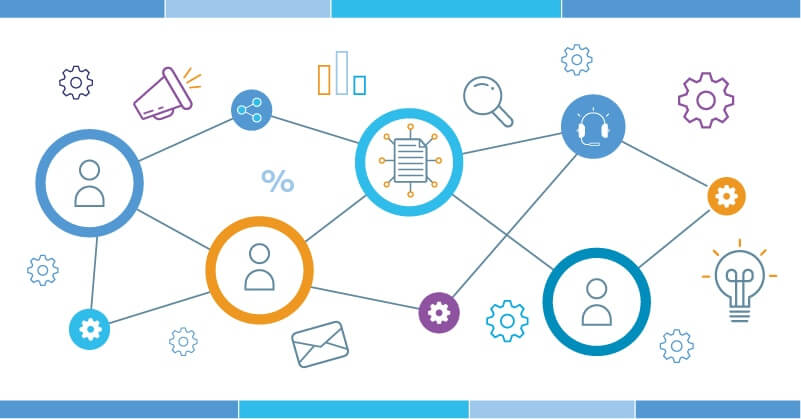
Customers are the lifeblood of any business, so it makes sense to have information in place that tells you as much as possible about your customer - their needs and experiences. With the advent of computerisation, it was expected that some of the earliest software applications manage customer data. These systems evolved from simple client lists to the sophisticated management systems of today that can store everything from client demographics and shopping behaviour, both instore and online, to data gathered from social media.. Obviously no company now can be without a customer relationship management (CRM) system, a critical business tool.
Since the introduction of CRM systems in the 1990s, the implementation failure rate has been disturbingly high. While you would expect that the failure rate would fall off as the products and the market matured, the same reasons crop up again and again as to why CRM projects fail.
Here are some statistics on CRM failures over the last 13 years.
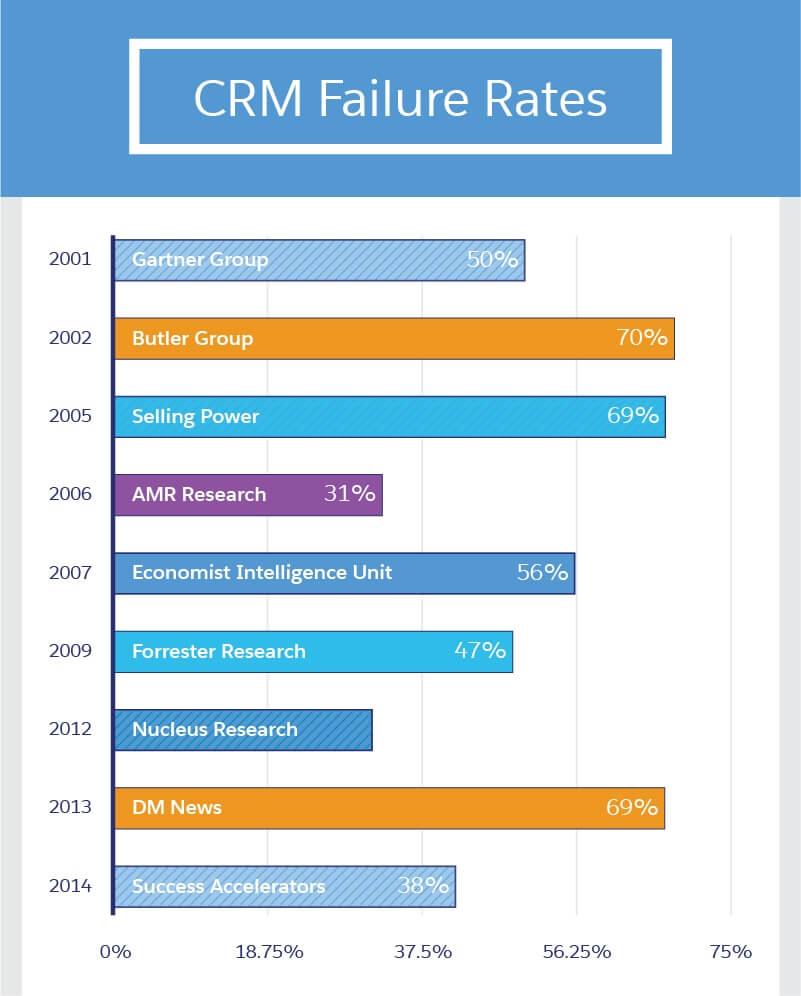
These statistics may not reflect CRM implementations that fell short of expectations, where the companies live with below-par performance and little to no ROI. However, it is not all doom and gloom; there are companies who have achieved very successful implementations by avoiding the common pitfalls that can derail a CRM project. All of the companies listed in the graph above, identified why their CRM implementations failed, from this we can learn how to avoid or fix these common points of failure. For instance, Forrester (2009) mentions these four factors as key contributors in why CRM projects fail:
- Lack of a coherent CRM strategy
- Lack of attention to process
- Focussing on technology, rather than people
- Failure to adopt, once implemented.
Causes cited by other sources include:
- Lack of executive commitment
- Poor data quality
- Lack of alignment with the existing IT architecture
In fairness it must also be pointed out that most of the points above can also be applied to any IT software project. Today, even with the adoption of agile development and best practices such as ITIL, software implementations are still risky projects, and thus is a contributory factor to why CRM implementations fail.
What is more, few people truly learn from history. In 2004, Philip Bligh wrote a book called "CRM Unplugged", where Chapter 2 discussed why CRM fails and how to fix it. He illustrates a set of risk factors collected by Meta Group in 2001 ( acquired by Gartner Group in 2005).
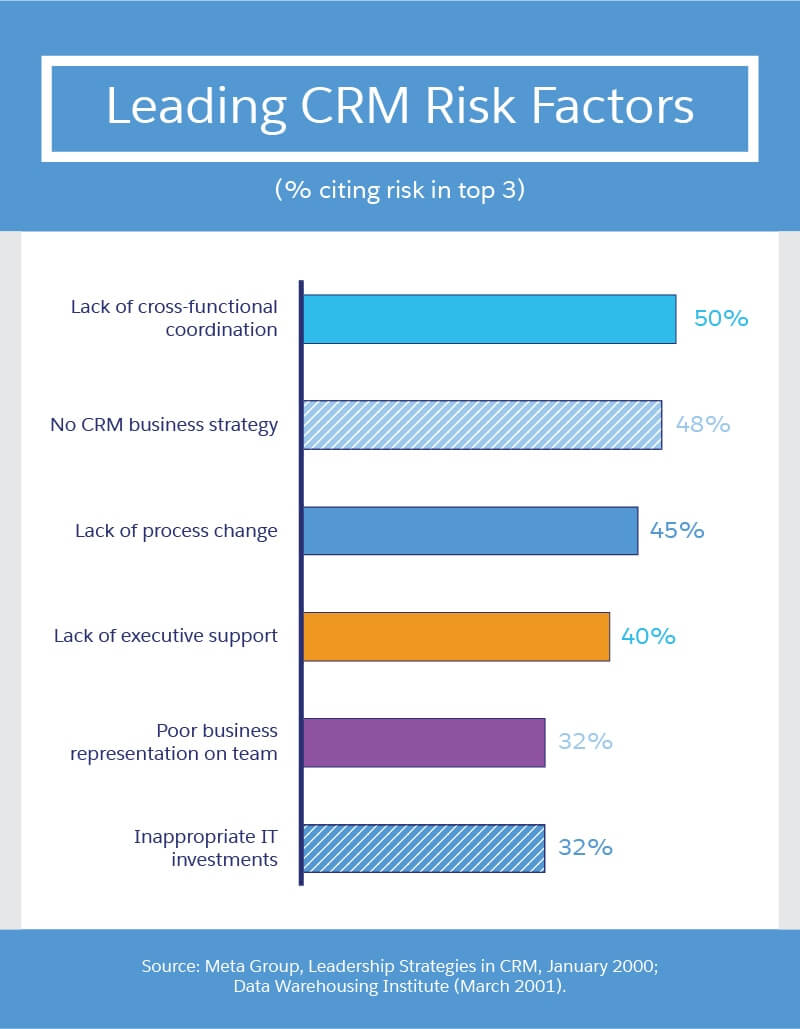
What’s the recurring pattern? No strategy, no process improvement , and poor executive support. In case you think that this information is outdated, things get worse instead of better. In 2014 Success Accelerators and C5 Insight found, not only that over one-third of CRM projects still failed, but that some companies had experienced 2 or 3 successive failures .
Surprisingly, there is a key factor that none of the research mentions explicitly, although all the above points arise as a result of it, and that is the disruption a new CRM brings to the business.
A Good CRM Implementation is a Disruptive One
Any company that intends to implement a CRM that will replace one or more legacy customer databases or older CRMs generally underestimates what a major change this will bring to the business. When you consider that nearly every employee depends on customer information to perform their jobs correctly, the true impact becomes apparent. Now add in the double whammy of new digital and social features that made you select this product in the first place. You’ll need the buy-in and participation of everyone who interacts with customers directly as well as those who use customer data in the course of their work. They are going to require training, and once the new CRM is implemented, there will need to be some change management to ensure the implementation sticks and encourages adoption.
However after all that, we still have not gotten to the root cause of the problem. If you are a disciple of Lean thinking, here is one of the " 5 Whys " for your root cause analysis.
"Why are you implementing a CRM in the first place?"
The answer to this is why CRMs fail; it is because you need to be customer-centric, and becoming customer-centric is hard, very hard, so many customer-centric initiatives fail.
The reason why changing from an organisationally-centred or product-centred approach to one where the customer is truly at the heart of your business is so difficult is because you have to turn your business model " Outside-In ". Somehow, " outside-in " sounds much more of a stretch target than " customer-centric ", and has been written about by others since Ranjay Gulati, such as George Day .
Why CRM Fails and How to Fix It
Develop your strategy and vision.
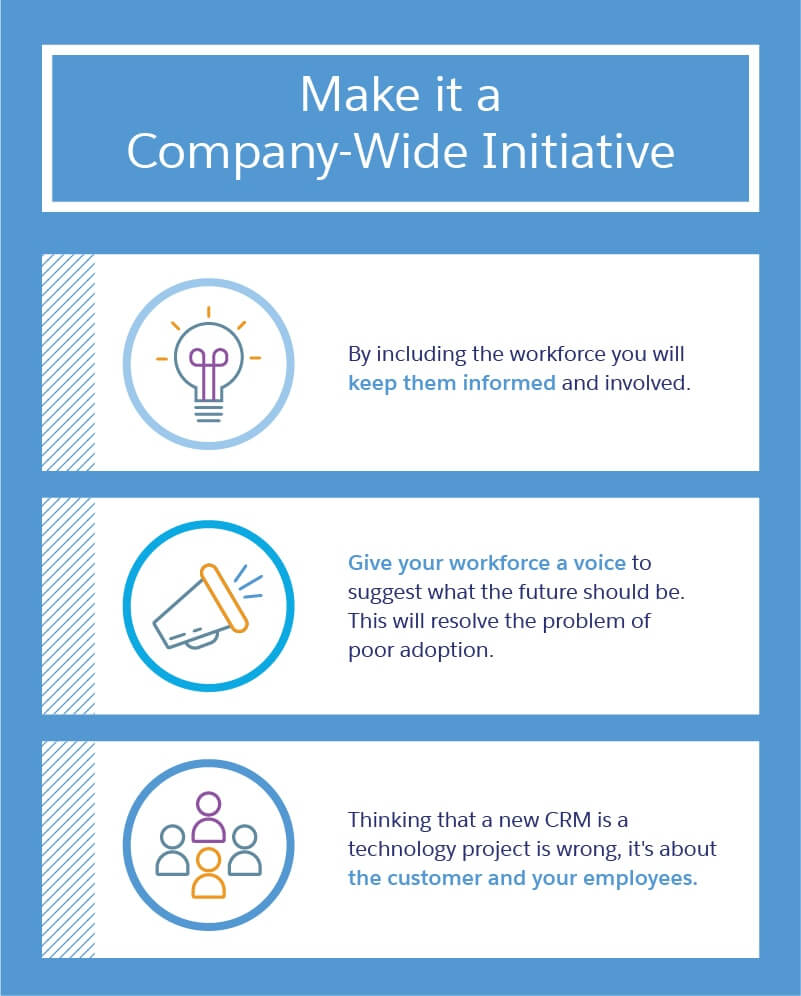
Appoint Sponsors and Champions
In order to keep the project top of mind, you need some committed individuals to sponsor the project and be champions in each of the business units. This is a major business change and the CEO should step up to the plate for the best results. Lack of sponsorship and commitment is a guarantee of any project failure and not just a reason why CRMs fail.
While we are discussing commitment, make sure that the CIO is bought in too.
Align your Processes with the Customer Journey
Start with a proof of concept, avoid garbage in, garbage out, keep to the pathway.
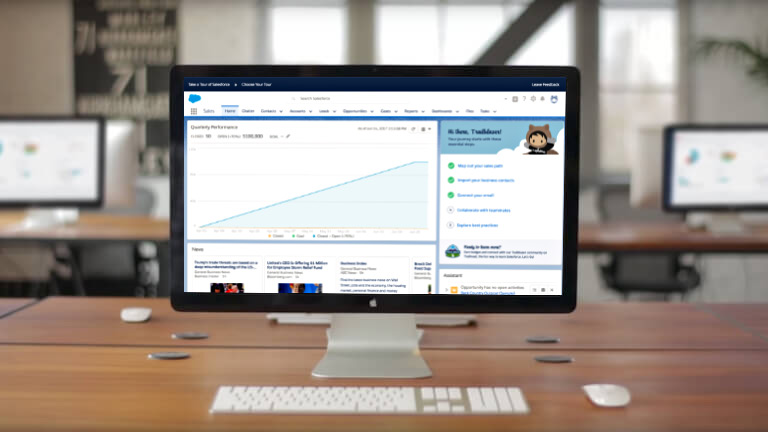
What is Salesforce CRM? Try it free for 30 days and see how it can help you grow your business.

CRM ensures your data is in one place and can easily be updated by anyone, anytime.
Questions we’ll put you on the right path..

How can you improve your digital adoption strategy? Take Apty's Free Assessment

- September 26, 2022
- Enterprise Applications
- Reading Time: 7 minutes
5 CRM Implementation Failures and How to Avoid Them
Table of contents.
“Do not be embarrassed by your failures; learn from them and start again.” – Richard Branson.
Since customers are a company’s lifeblood, it makes sense to have data that provides you with as much information as possible about your customers, including their requirements and experiences. With the advent of computerization, it was anticipated that some of the first software applications would manage customer data.
Simple client lists paved the path for the sophisticated management systems of today, which provide information on customer demographics, online and offline purchase patterns, and social media data. It goes without saying that a Customer Relationship Management (CRM) system, a crucial business tool, is now necessary for any firm.
According to CIO magazine , almost one-third of all CRM efforts fail. CRM system is helping businesses to grow, but the CRM implementation failure is closer to 90%.
What is CRM?
CRM refers to the systems used by businesses to keep track of their clients and utilize the information gathered to forge relationships with them that will boost sales.
Why Do CRM Projects Fail:
Setting defined goals is the first step in a CRM implementation. However, attaining unspecified goals could be challenging. . . Lack of clear, quantifiable objectives results in an aimless purpose, unclear success, unquantifiable ROI, and CRM failure. They are, at best, fragmentary capabilities that rarely drive any meaningful results.
There are many reasons for CRM implementation failure. Installing and configuring an application program without providing a great and enjoyable user experience for its users is akin to declaring a surgery successful, yet the patient finally dies.
Let’s look at the reasons for CRM implementation failure:
- Unclear goals for the new enterprise CRM
- CRM Investment Without planning
- Disregarded or dismissed IT implications
- Collaboration failure across departments
- Failure to train CRM users
1. Unclear goals for the new enterprise CRM:
You could be tempted to design a system that serves everyone because CRM software can assist many different departments in your company. Big aspirations for your system are admirable, but losing focus can lead to disaster if your CRM project is only getting started. It’s hard to assess your CRM’s success without precise, quantifiable goals.

Start by asking the question – ‘What problem are we trying to solve with this system?’ come up with answers and brainstorm on them; Make sure to define your long-term and short-term goals.
Instead of none, having too many goals might give you a headache. According to Scott Edge – “Today’s CRMs also serve a wide range of masters, including C-suite executives, technology, marketing, finance, and sales. They attempt to address more goals than any software system can reasonably handle.”
Review these objectives periodically and make necessary adjustments as your business grows and your team’s CRM use changes.
2. CRM Investment Without Planning:
Businesses that spend a lot of money on Customer Relationship Management without first taking the time to assess their needs are likely to fail. Therefore, the reasons why a CRM fails frequently have less to do with the platform’s capabilities and more with how the company views itself.

A company that invests in software that streamlines emails and text messages may encounter a CRM failure if its consumers prefer to communicate via phone or in person. Before investing in Customer Relationship Management software, a company should evaluate its marketing and sales scenario to avoid unsuccessful CRM actions.
A business may create a productive platform by carefully considering and evaluating how to connect a CRM system with its customers, workflows, and specific requirements.
3. Disregarded or dismissed IT implications:
You might not realize the full impact of your CRM system until it’s too late. It’s crucial to take current IT infrastructure and investments into account.
The purchase of a SaaS solution is a very complicated procedure. In fact, 77% of B2B buyers said their most recent acquisition was “extremely complex or tough.” Six to ten stakeholders typically make up the buying committee, according to Gartner . The IT staff is often not a part of this group.
Business units are considerably more likely to experience integration, customization, support, and upgrade issues when they purchase CRM systems without the help of their IT counterparts. The process of choosing and deploying a CRM is hard and risky.

It may identify important dependencies, standards, and must-have features throughout the assessment and selection process. The IT department can handle data backup and migration before installation. Additionally, when teams use CRM software, it may help with support inquiries, technical issues, and other challenges.
There is no assurance that users will feed the system with accurate data once it Is deployed. However, you’re more likely to get a great ROI if you have specific objectives, including users, executives, and your IT staff.
4. Collaboration Failure Across Departments:
One of the main causes of CRM’s failure is the difficulty in getting departments to work together on utilizing the CRM. CRM success is mostly driven by the cooperation between the marketing and sales teams.
Although Marketing and Sales may play different roles in acquiring and developing leads, both are crucial to generating leads and turning them into paying clients.
Marketing must define target audiences, create and implement tactics to effectively contact them, qualify leads, and pass them along to sales. Sales must assess the leads that marketing sends their way, nurture leads through each stage of the sales process, and close the deal once the lead converts.

Each of these tasks must be supported by a CRM system. However, CRM works best when Sales and Marketing work together to develop integrated lead generation and customer acquisition strategies.
For instance, Leadsquared offers all relevant details on a lead in a single, user-friendly location. Through this interface, Sales and Marketing may collaborate to turn this data into strategies and materials that will effectively attract clients.
5. Failure to Train CRM Users:

Team members are more likely to stop using a CRM if they don’t feel comfortable using it. For instance, the time lost when an employee takes too long to figure out how to use a CRM feature may exceed whatever advantages the feature offers the company.
Businesses should concentrate on CRMs that are: Simple to use; and Training-rich to avoid CRM failure caused by a lack of training. Team members can use CRM easily and quickly when tasks are automated.
Have a look at our Top 10 CRM software for high productivity
CRM Implementation Failure Rate:
About one-third of all Customer Relationship Management (CRM) efforts fail, according to a CIO magazine article. That was a dozen analyst reports on average. The percentages varied from 18 to 69 percent. Failures like this can be caused by various reasons, including overspending, problems with data integrity, technological constraints, and more. However, according to CIO Magazine failure rate is closer to 90%.
CRM systems primarily fall short of their potential to assist businesses in growing their revenue because they are frequently used for inspection – to report on progress, improve forecast accuracy, provide visibility, forecast project delivery dates, and provide a range of other business intelligence – rather than for improvement in the sales process.
Front-line sales reps and management hardly ever find the majority of these skills useful in producing new revenue for the business.
CRM implementation failure examples:
Here are CRM implementation failures with the best examples so that any business can learn from them:
A. British Airways:
They used to provide subpar customer service and had a history of CRM failures. British Airways used an Oracle-based CRM named Ocean Wave in 2001. It was known as a “Customer Data Warehouse” by them.
Its implementation took two years because of several issues, including
- Complexity: The data format was challenging to utilize because it wasn’t designed to be used for analytical reasons.
- Poor performance: since it was also utilized as a source of operational data, which affected analytical users.
- Time-consuming training: Too much work and time were used in training SAS (Statistical Analysis System) users.
- Poor data quality: Analytical team lost faith as they could not comprehend the unclear data.
B. Vodafone:
For breaking customer protection laws in 2016, the British multinational corporation Vodafone was hit with a £4.6 million fine.
They received a fine for collecting money from pay-as-you-go clients and improperly addressing complaints. With the intention of integrating it with its Oracle billing system, Vodafone chose CRM. The new CRM system was implemented to handle data networks, fixed-line telecom consumers, TV subscribers, and mobile customers.
Many consumers complained about their billing, and the new system had several hours of outage. Others were entirely blocked from accessing their internet accounts despite expired contracts. Ofcom (Office of Communications) opened an inquiry into the business because of increased consumer complaints. The £4.6 million fine and its £54 million sales loss extended the company’s losses to nearly £59 million.
Vodafone’s customer service was poor prior to the installation of its CRM. Starting such a massive CRM project with a poor opinion of customers was only going to make things worse. To prevent the disastrous tragedy, Vodafone should have provided their staff with customer service training and the tools they needed to assist clients using the new CRM system.
How Apty helps boost CRM implementation:
Businesses use the Digital Adoption Platform (DAP) to get over adoption and implementation issues with CRM. Apty can effortlessly interface with your current CRM system and offer in-app guidance to assist your staff in completing daily duties.
Apty analytics enables you to identify the areas where your employees are struggling. You can design specialized walkthrough solutions to get over these obstacles and increase their efficiency.
With the aid of Apty Assist, users can accomplish their tasks quickly and are prompted if they make any mistake within the system. The information required to make the most of the CRM is available within the system, making the employees’ life easy. Apty operates effectively on several CRM systems, including Salesforce, MS Dynamics 365, and Oracle CX.
Subscribe to our Apty Blog
Join 6000+ monthly readers learning about best practices, solutions, and strategies to drive software adoption
Latest Blogs
Introducing apty’s enhanced content creation experience: tailored to increase productivity of content creators, enablement smes, and l&d departments , announcing apty’s enhanced content creation experience: the fast and intuitive way to create software training content and streamline release management , how digital transformation and change leaders use apty’s enhanced content experience to boost organization productivity, make your enterprise software work.
- Post Updated On: August 24, 2023
Sandeep Chowdary
Your recommended articles.

Apty: Recognized as a Leader among Digital Adoption Platforms in IDC MarketScape 2024
Driving digital transformation through software adoption.
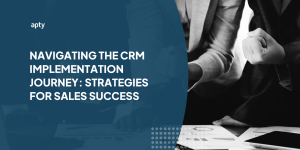
Navigating the CRM Implementation Journey: Strategies for Sales Success
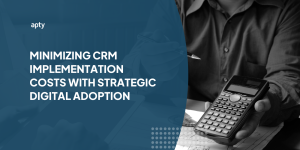
Minimizing CRM Implementation Costs with Strategic Digital Adoption

From Data to Decisions: Transforming CRM Sales Forecasting with Digital Adoption

Why Enterprises are Prioritizing Software Adoption in 2024

Digital Adoption Done Right

For Applications
- MS Dynamics
- Homegrown Applications
- Change Management
- Digital Transformation
- Onboarding & Training
- Data Quality Improvement
- Business Process Compliance
- DAP Downloads
- Apty vs Whatfix
- Apty vs WalkMe
FAQs Customer Support Center Partner Portal
- [email protected]
- [email protected]
- [email protected]
- 1524 S I-35 Frontage Road, Suite 224, Austin, TX - 78704
- MS Dynamics 365

Copyright © 2024. Apty. All Rights Reserved. | Privacy Policy | Terms & Conditions Made With Team Apty
Want to Learn More?
Subscribe to our Monthly Apty Newsletter to get exclusive content, digital adoption best practices, and more. It will be delivered straight to your inbox.

CRM case studies: how the biggest businesses use CRM
Whether you have taken the plunge or not, CRM vendors will tell you that CRMs are a must-have piece of software if you are involved in the sales or service industry. And there is no reason to question their statement; research shows that for every dollar you spend on CRM, you receive a return of $8.71 . And that’s not all. As CRMs become even better at what they do, the average ROI is set to continue to rise.
The benefits of CRM
Whether you are based in the US or elsewhere, CRMs enable businesses around the world to improve and build on customer relationships, hone internal processes, boost communication and increase lead conversion rates by as much as 300% . This latter figure is one that you cannot afford to ignore. No matter how well your business is doing at the moment, with the right CRM in place, it can do even better.
Check out the top ten CRM features than bring the highest ROI in our free guide
But before you travel down the road to CRM, investing time and money, take the time to establish exactly what type of CRM will work best for you. Study consumer feedback and get input from employees that will use the system. You can only keep your customers happy, all-singing and dancing by putting your money into an effective CRM that is a perfect match for your needs. If you want to find your business in the ‘successful CRM implementation case studies’ category, creating a detailed CRM implementation strategy is vital. You should also take the time to look at several CRM implementation case studies, successful and unsuccessful.
Successful CRM implementation case studies
For those interested in investing in CRM software, taking a look at CRM case studies and success stories is time well spent. By looking at the way that others have done it right – and wrong – you can fine-tune your own CRM requirements strategy.
Check out this guide to gathering your CRM requirements for an overview
By evaluating other companies’ case studies, you can see how CRMs have enabled some of the biggest businesses to use it as they should, resulting in a happy bunch of customers and vastly strengthened customer relationships.
Let’s take a look at a couple of examples:
Wells Fargo
Here we have a company tasked with keeping track of the property and assets of as many as 70 million people. To them, customer service has to be absolutely spot on. As one of the biggest banks in the US, Wells Fargo knows that in order to maintain their competitive edge, they need to go the extra mile when looking after clients. In order to do this well, they make good use of CRM social media connectivity, enabling them to communicate easily with clients that need to talk. Their CRM is also used to make certain that when problems arise, the issue is dealt with by the correct department within the organization. This eradicates the type of scenarios where clients are sent in circles, from department to department, endlessly trying to get an answer. The result is that they build fantastic relationships with clients, achieving a customer retention rate that is one of the best.
A leading publisher in the US, Activision are heavily into the American video game market and has been so for more than three decades. Back in 2011, ‘Modern Warfare 3’ achieved the title of being the ‘largest and most successful entertainment launch in history’. Unbelievably, it made $400 million in just 24 hours! But Activision knew that money alone could not be their only measure of success. They are very big on customer service, providing an unrivaled communication service to their gamers. Their aim is to keep them happy long after the purchase is made. By using a CRM system, they monitor conversations within social media where they appertain to their products, following up to ensure that any problems are dealt with efficiently and positively. Because social media customer service is so affordable when compared to other methods, the company was able to reduce its customer service operating costs by 25%.
Failed CRM implementation case studies
But it doesn’t always go well. At times, some of the biggest businesses get it wrong when it comes to CRM, as can be seen from other CRM case studies.
Here we have a story of a fairly large consulting firm that needed some process design work carried out on their new CRM implementation. However, when they asked for help, the installation was already ongoing and the system was already being built. So why were they asking for help at this stage?
This particular CRM case study takes place a couple of years in the past. The company had made a decision to put in place the “best of breed” CRM system to automate its sales force. They also pulled in one of the world’s largest CRM consulting firms to customize the software.
But things began to go wrong. The consulting firm quoted a figure of $20 million for them to design and customize the new CRM tool. The CIO felt that this was much too high and threw the price back at them, resulting in the consultants not only reducing the price but lowering the scope of work as well; they would make the same margin but do less work. The price was cut to $12 million by removing all of the business consulting related to the technology. This included the process definition, business logic, and work flow etc. Basically, this was everything that the CRM was supposed to automate.
But the CIO made a massive error, believing that all of these processes already existed or could be developed in-house. The fact was, they did not and the company had nothing to start with. Realizing their mistake, the company began to recruit hordes of additional consultants to take care of the creation and automation of the sales and marketing systems. The systems integrator was asking them to automate content that didn’t exist. Now the budget began to rapidly expand, quickly surpassing the original figure of $20 million.
Added to this, the brief had originally been limited to dealing with the automation of order entry and other basic sales tasks but it didn’t stay this way. Now it has become an ever-growing wish list of must-have CRM features . It was decided that while they were at it, they could automate the pricing process, add a product configuration tool and integrate with the ERP.
The scope of the CRM functionality and the requirement of the business to quantity the underlying processes soon spiraled way out of control. In the end, the company spent $90 million on the CRM tool, paying the vendor $15 million and consultants $75 million!
But worse was to come. No-one in the company ever got to use the CRM as it was never successfully deployed. Years later as the economy slowed down, the company gave up on the system and finally went out of business.
What do these CRM case studies mean for CRM?
As can be seen from these case studies, CRM can either be used incredibly well or exceptionally badly.
This may be due to the fact that instead of seeing a CRM as what it is; an incredibly efficient piece of software that can dramatically increase a company’s ROI, they see it as a magic cure-all that will solve all that is wrong with the business. But a CRM only enables systems to work better. By itself, it cannot resolve things that are going wrong, but it will help a company to do things better and faster. Before any type of CRM system is put in place, businesses of all sizes need to decide how they want the business processes to work before they’re automated, and to be sure that these processes actually exist. Don’t make the mistake that the CIO made in the CRM case study above.
Check out our CRM comparison tool to compare CRM systems based on features and functionality
Spending a whole load of money on the most expensive system out there isn’t going to necessarily work unless you do your groundwork. A good idea is to begin with the basics and then add to what you have once it is working well. The most crucial part of using a CRM system is the work you do before it is deployed i.e. putting together a CRM selection team and then creating a detailed CRM requirements document, based upon precisely what your business needs. This should include the organizational and automation of everything related to customer interaction, such as marketing, sales, customer service and customer support. The right CRM for your business will analyze all customer interactions and provide you with a way of improving and building upon the customer relationship.
The CRM requirements stage is so important that it can be responsible for the success or failure of your CRM success. Getting it wrong not only costs time and money but can result in the system never actually being deployed. This in itself can be the death-toll for many businesses, even the largest.

Free white paper

Top 10 CRM comparison
Compare the top CRM systems using this guide
- I would like to receive free CRM resources via email

Click here if your download doesn’t start automatically .
Featured white papers

CRM implementation guide
Plan your CRM implementation successfully with this comprehensive guide

CRM software vendor directory
Save hours of CRM vendor research with this free guide

CRM software selection checklist
Plan your CRM selection project with over 100 actionable steps to success
Sign up to our newsletter Sign up
Your first CRM newsletter should arrive in your inbox soon.
Related articles

The CRM implementation process: a six step plan for success
All the information you need to roll out your new CRM successfully
- Implementation

Four people you need on a good CRM team
A good CRM team will help with implementation immensely - make sure yours contains the right people

Five reasons for CRM implementation failure
CRM implementation failure is all too common - but it is easy to avoid if you know how

Causes of CRM Failure
- Post last modified: 21 November 2023
- Reading time: 11 mins read
- Post category: Technologies

Too often management views CRM as an easy solution to their business problems.It is often initiatives that begin and unfolds the management realizes the gaps in the expectations. Some of the causes of CRM failure are:
Mistaking CRM as the substitute for good marketing management
Failure to appreciate the dynamic nature of marketing, inadequate appreciation of the potential of the customer database, failure to use brand intelligibly in the crm programme, reluctance to measure customer satisfaction precisely, failure to follow up the feedback from the customers, reluctance to share the data on customers with all staff, ignoring the need for efficient, trained, well-motivated employees, some crm programmes incur very high costs, failure to appreciate that the scope for crm varies over businesses, failure to fit in the needed flexibility, poor planning affects business goals, resistance to change, commitment from senior management.
Table of Content
- 1.1 Mistaking CRM as the substitute for good marketing management
- 1.2 Failure to appreciate the dynamic nature of marketing
- 1.3 Inadequate appreciation of the potential of the customer database
- 1.4 Failure to use brand intelligibly in the CRM programme
- 1.5 Reluctance to measure customer satisfaction precisely
- 1.6 Failure to follow up the feedback from the customers
- 1.7 Reluctance to share the data on customers with all staff
- 1.8 Ignoring the need for efficient, trained, well-motivated employees
- 1.9 Some CRM programmes incur very high costs
- 1.10 Failure to appreciate that the scope for CRM varies over businesses
- 1.11 Failure to fit in the needed flexibility
- 1.12 Poor planning affects business goals
- 1.13 Resistance to Change
- 1.14 Commitment from senior management
Many marketing managers view a CRM programme as the substitute for marketing management assuming that the programme would lessen the hard work involved in marketing. They place excessive expectations on the CRM software and think the software will by itself look after their customer management tasks.
No CRM programme can substitute the hard grind that marketing is all about. CRM requires superior marketing managers and staff, who are not only sensitive to the customers but also willing to put in the needed work in the execution of the CRM programme.
Customers’ needs and the value they perceive in various offerings are subject to change over time. Technology and environment to keep changing, affecting the firm’s customer management strategy. When a CRM programme does not take cognizance of this dynamism of marketing, it fails.
Preoccupation with a gathering of data and neglect of its application: Application of the insights on customers to marketing action is the core of CRM. The usefulness of this expenditure depends entirely on the extent to the information is applied to marketing actions.
The firms lack adequate appreciation of the potential customer base. Their CRM programmes remain as just, PR programmes. They stop with just quarterly customer mailings or monthly customer letters. Measurements of customer satisfaction and protocols for applying the results there of for calculating the efficacy of marketing are usually non-existent.
Using brand intelligibly is the key to successful mass marketing. It is seen whenever the brand and its values are not utilized throughout the CRM process, the results are not favourable. The way customers interact with brands has been changing in recent years. Multiple channels have contributed to this.
This means that in the present times, the brand must work in all the channels/media and all the levels/touchpoints at which the communication takes place. CRM must first know how the customers consume its brand and how they relate to it.
Using this knowledge, the brand’s value proposition and the various benefits it offers should be tailored to the individual customer and communicated to him in a specific way.
Manny managers are reluctant to precisely measure the level of customer satisfaction. They also fail to set clear parameters/ metrics for this measurement. Obviously, these managers have no way of finding out whether CRM implementation has brought in benefits or not.
Analysis shows that in many cases, firms painstakingly gather feedback from customers, but afterwards forget about it completely. After coercing the customers to fill in any number of feedback forms, suggestion forms and survey questionnaires, they make no attempt to action the feedback or to initiate a further dialogue with them. This is worse than not gathering feedback at all.
Many firms have a protectionist approach to information. Their thinking is that information should be made available only on a ‘need to know’ basis within the organization and must be tied closely to rank. This is anti-ethical to CRM. CRM programmes believe in making all relevant information available to all those in the organization, who interact with the customer in one way or the other.
Happy customers are the outcome of happy and well-motivated employees. And such employees bred only in great workplaces. Companies can succeed in CRM only by having efficient, well-motivated and happy employees.
The challenge is often with the speed of response. The firm must resolve customers’ problems adequately and quickly. Employees with the right motivation ‘customer –first’ attitude create a satisfied customer.
Running a CRM Programme, especially the creation and maintenance of an effective customer database involves significant costs. There are software costs, hardware costs, systems costs, people-related costs, training and motivation costs and so on.
The business must be capable of generating such revenues and profits that costs of CRM programme do not pose a problem at all. There must also be proper control of the costs of CRM-both investment costs and operation costs. The CRM programme succeeds only when the net is positive.
All businesses and all customers do not lend the same scope or applying CRM. Failure to appreciate this basic fact will lead the CRM programme to failure.
For example, in FMCG businesses where the end customers run into millions and are a distance from the company by several tiers of middlemen and geography, a one–to–one relationship is difficult to maintain. They may be better of with traditional mass marketing/communication strategies.
In some cases, CRM programmes fail as they are designed without the needed flexibility. A rigid structure will be incapable of supporting one-to-one marketing. It will not be able to respond to individual customers’ needs in specific ways.
Poor planning affects the company’s views of interaction with customers and increases the chances of addressing the wrong issues. Planning must be based on creating new initiatives that will make doing business better for the customer. It includes taking small steps to reach the larger goal.
Remaking a company to be genuinely customer-centric is new and uncharted territory and as with anything new, there is always resistance to change. Change often forces people to regress to what they know and protect what they have always been comfortable with.
A solid and total commitment from the most senior management is a must for the CRM project work. The project must have a dedicated senior executive with the strength to sell the program throughout the organization as is champion, assuring the company’s commitment.
Business Analytics Tutorial
( Click on Topic to Read )
- What is Data?
- Big Data Management
- Types of Big Data Technologies
- Big Data Analytics
- What is Business Intelligence?
- Business Intelligence Challenges in Organisation
- Essential Skills for Business Analytics Professionals
- Data Analytics Challenges
- What is Descriptive Analytics?
- What is Descriptive Statistics?
- What is Predictive Analytics?
- What is Predictive Modelling?
- What is Data Mining?
- What is Prescriptive Analytics?
- What is Diagnostic Analytics?
- Implementing Business Analytics in Medium Sized Organisations
- Cincinnati Zoo Used Business Analytics for Improving Performance
- Dundas Bi Solution Helped Medidata and Its Clients in Getting Better Data Visualisation
- What is Data Visualisation?
- Tools for Data Visualisation
- Open Source Data Visualisation Tools
- Advantages and Disadvantages of Data Visualisation
- What is Social Media?
- What is Text Mining?
- What is Sentiment Analysis?
- What is Mobile Analytics?
- Types of Results From Mobile Analytics
- Mobile Analytics Tools
- Performing Mobile Analytics
- Financial Fraud Analytics
- What is HR Analytics?
- What is Healthcare Analytics?
- What is Supply Chain Analytics?
- What is Marketing Analytics?
- What is Web Analytics?
- What is Sports Analytics?
- Data Analytics for Government and NGO
- What is E-Business?
- E-Business in India
- What is Mobile Commerce?
- E-Business Strategies
- E-Business Revenue Model
- What is E-Commerce Software?
- What is Electronic Payment System?
- What is Payment Cards?
- What is Payment Gateways?
- Types of Payment Systems
- Security Threats in E-Business
- Online Security in E-Business
- What is Online Marketing?
- What is Website Usability?
- What is Web Advertising?
- What is E-Mail Marketing?
- What is Online Brand Management?
- What is E-CRM?
- What is E-Supply Chain Management?
- What is E-Retailing?
- What is E-Banking?
Enterprise Resource Planning
- What is Enterprise Resource Planning?
- Benefits and Advantages of ERP & Reasons for Growth
- Success Factors of ERP Implementation
- ERP Implementation Life Cycle
- Risk in ERP Implementation, Cross Function, ERP Technology
- Maintenance of ERP
- What is Business Model?
- Business Process Reengineering (BPR)
- Types of Information Systems: TPS, MIS, DSS, EIS
- What is SAP?
- Modules of ERP Software
- SAP Application Modules
- SAP R/3 System
- ERP Modules
- ERP in Manufacturing
- ERP Purchasing Module
- What is SAP Sales and Distribution (SAP SD)?
- ERP Inventory Management Module
- ERP Implementation
- ERP Vendors, Consultants and Users
- Oracle Corporation
- PeopleSoft ERP
- Edwards & Company ERP
- Systems Software Associates ERP
- What is ERP II?
- ERP Implementation at Rolls-royce
Management Information Systems
- What is MIS?
- Requirements of Management Information System
- What is Risk Management?
- Nolan Six Stage Model
- What is Cloud Computing?
- Information Systems in Organisations
- Challenges Faced by Manager in Managing Information Systems
- Decision Making With MIS
- What is E-Governance?
- What is Green IT?
- What is Smart Cities?
- What is IT Infrastructure?
- Cloud Service Models
- Cloud Migration Challenges
- Security Threats Faced by Organization
- Managing Security of Information Systems
- Software Project Management Challenges
- What is Data Management?
- What is Database?
- What is Data Warehouses?
- Enterprise Resource Planning Systems
Project Management
- What is Project Management?
- Functions of Project Management
- What is Project?
- Project Managers
- What is Project Life Cycle?
- Project Feasibility Study
- What is Project Analysis?
- What is Project Planning?
- What is Project Selection?
- What is Project Schedule?
- What is Project Budget?
- What is Project Risk Management?
- What is Project Control?
- Project Management Body of Knowledge (PMBOK)
- Best Project Management Tools
- What is Project Organisation?
- What is Project Contract?
- Types of Cost Estimates
- What is Project Execution Plan?
- Work Breakdown Structure (WBS)
- Project Scope Management
- Project Scheduling Tools and Techniques
- Project Risk Identification
- Risk Monitoring
- Allocating Scarce Resources in IT Project
- Goldratt’s Critical Chain
- Communication in Project Management | Case Study
- Plan Monitor Control Cycle in Project Management
- Reporting in Project Management
- IT Project Quality Plan
- Project Outsourcing of Software Development
- Implementation Plan of Software Project
- What is Project Implementation?
- What is Project Closure?
- What is Project Evaluation?
- What is Project Management Office (PMO)?
- IT Project Team
- Business Case in IT Project Life Cycle
- PMP Study Guide
Emerging Technologies
- What Is IoT?
IoT Design and Size & Space Considerations
- IoT Architecture
- Iot Applications
- IoT Security Challenges
- Big Data Processing Frameworks
- IoT for Smart Cities
IoT Consumer Wearables and Application
Smart retail iot.
- What is Augmented Reality?
- AR Applications
What is Virtual Reality?
You might also like, benefits of online education in a virtual classroom, data governance vs. data quality management, what is augmented reality business models, privacy concerns, ar for enterprise, power of retrieval-augmented generation in enterprise settings, 10 outstanding undetectable ai tools enhancing text humanization, why app developers should crack the code of internationalization and localization, finding your fit: how to choose the right event management technology, applications of iot (internet of things), leave a reply cancel reply.
You must be logged in to post a comment.
World's Best Online Courses at One Place
We’ve spent the time in finding, so you can spend your time in learning
Digital Marketing
Personal Growth

Development
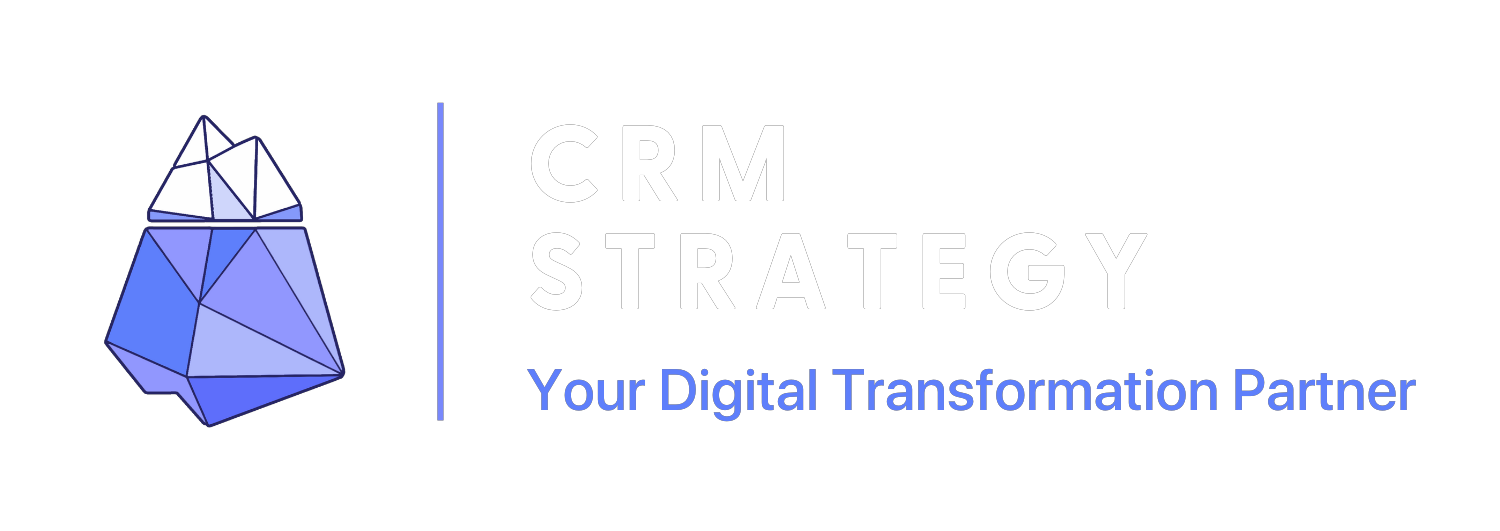
10 common causes of CRM failures and how to prevent them.
Many companies struggle to implement and maintain their CRM change programmes. Here are 10 of the most common causes of CRM implementation failures and thoughts on how to prevent them.
Lack of a clear strategy: This strategy should define the objectives, KPIs, and the tactics to achieve the goals. Without a clear strategy, the implementation and management of the CRM system will be unfocused and ineffective.
Solution: State the business problem the CRM is to solve. Seek advice from a partner on realistic timeframes and budgets to achieve your goals. Create clear, measurable goals and KPIs, and share them with all relevant stakeholders.
Poor data quality : Poor data quality can lead to inaccurate information, duplicated records, and unusable experiences. This leads to a lack of trust in the system, uninformed decision-making, missed opportunities, and poor customer service.
Solution: Expect and plan for ongoing data clean-up. If this is your first CRM, then there will be a task to make the data useable. Establish data quality processes that ensure data is accurate and current. Implement data cleansing, de-duplication, and validation procedures. Empower staff where appropriate to take responsibility for ensuring the system is accurate and up to date.
Inadequate user adoption: A CRM system is only effective if it is widely adopted by users. Many companies struggle with user adoption due to a lack of training, bad data (above), incorrect configuration or user-unfriendly interfaces.
Solution: Provide comprehensive training and support to users and make the system as user-friendly as possible. After initial training, check in and offer remedial training for users who may need it. In the initial planning stages, include voices from as many departments as you can to ensure the design is right for all users. Set up super-users within your businesses who other users can trust and come to for advice.
Insufficient customisation: A CRM system needs to be tailored to the specific requirements of your business. A lack of customisation can lead to awkward usage models, inadequate reporting, data analysis, and automation.
Solution: Work with your CRM partner to customise the system to meet your requirements, including data fields, reports, and automation rules. Test, test and test again. Plan for ongoing customisation, as the CRM will need to evolve with your business’s needs.
Poor integration with other systems: To ensure the unified view and customer experience you’re seeking to deliver, your system should be integrated with other systems, such as marketing automation, ERP, and e-commerce. Bad or lack of integration can lead to data silos and inefficiencies.
Solution: Map the flow of data. Decide which system should be the source of truth. For example, CRMs often own contact and sales information, while other systems own financial or marketing data. Ensure that the CRM is integrated with other relevant systems, and test scenarios where data conflict may occur. Also consider time of sync (do you need real-time data, or are scheduled updates sufficient?) Seek advice from your vendor or partner about best approaches.
Lack of executive buy-in: The CRM’s success depends on executive buy-in. Companies that can’t get the necessary support and funding from the executive level often struggle to leverage the value of the system.
Solution: The commissioning of a CRM is a business decision, not a technical one. The leadership groups and executives should be active users of the system and directly benefit from its capabilities. When executives use the system, their support teams will naturally use it as well.
Inadequate ongoing support: Like any business investment, a CRM requires ongoing support to ensure that it remains effective and up-to-date. Many companies fail to provide adequate support, leading to obsolete data, outdated processes, insecure data polices and user frustration.
Solution: Ensure your system is maintained under the appropriate maintenance agreement. Maintenance is an ongoing running cost and should be planned for. A well-maintained CRM running the latest software on a secure server, carefully monitored and updated, will be far more likely to deliver the change and improvements it was commissioned for.
Lack of focus on the customer experience: CRM is all about improving the customer experience, but many organisations skip this aspect of their implementation. A substandard customer experience can lead to lost business and poor brand reputation.
Solution: Understand your customer journey and customer personas. The CRM should be configured to serve these in natural, customer-centric flows. Screen design, automations, integrations and communication functions all play important roles in allowing your staff to serve your customers better.
Inadequate measurement and analysis: Your CRM should be used to measure and analyse customer behaviour, interactions, preferences, and trends. If you don’t analyse the right data, decision making will be affected and you’ll miss out on the upside of data-driven customer insights.
Solution: Most CRMs provide either strong internal reporting or the ability to connect to reporting tools. The issue isn’t so much in the ability to report, but deciding on what to report. Establishing KPIs and measuring those is a natural place to start. Like the rest of the system, the analytics components of a CRM are designed to be flexible, so experiment on the types and frequency of reports might work best.
Resistance to change: A common cause of CRM failure is resistance to change. Employees might resist adopting new systems or processes, leading to poor adoption rates and ultimately, underutilisation, spotty data and low ROI.
Solution: Take on your employees’ concerns and resistance to change through comprehensive change management processes, including communication, training, and support. Involve employees in the CRM implementation as early as possible to increase their buy-in and ownership. Listen to the detractors. Often they have useful insights and if you can address these, they can often become proponents of the system
Well implemented CRMs can drive significant revenue growth and improve customer experiences. But they aren’t silver bullets and do require hard work from all involved in the design, implementation, and end use to bring about this value.
At CRM Strategy, we’ve helped customers achieve their goals for over 26 years. If you need assistance in how to approach implementing a CRM, get in touch. We’d love to talk.
1300 276 669
2/1 Hardner Road, Mt Waverley, Victoria, 3149, Australia
Level 32, 101 Miller Street, North Sydney, NSW, 2060, Australia
- CRM Strategy Services Guide
- CRM Strategy Insights Newsletter
- How to find us
- CRM Concepts
- Crafting a CRM Strategy
- CRM Strategy + Zoho: Fast results & Flexibility
- Privacy Policy
Office Opening Hours
Mon: 9am – 5.00pm
Tues: 9am – 5.00pm
Wed: 9am – 5.00pm
Thur: 9am – 5.00pm
Fri: 9am – 5.00pm
Sat: Closed
Sun: Closed

12 Successful CRM Implementation Case Studies to Learn From

CRM implementation can seem like a monumental task to complete. From knowing which CRM to choose, to understanding how to fit it in with the rest of your sales stack , there’s a lot involved from pricing to convincing decision-makers to making sure it works well from the start.
If you’re looking for CRM implementation case studies to give you ideas and confidence to get started, then look no further.
12 CRM Case Studies
Want to get this done right (the first time)? Learn from the CRM case studies of companies that implemented a new CRM successfully to improve the customer experience, drive customer engagement , and increase revenue.
1. How Customer.io Uses Automated Handoffs to Enable Smarter Sales
Company: Customer.io
Customer.io is an established martech provider that needed a CRM to work better with both an inbound and outbound sales process. Plus, they needed it to fit well with their current tool stack and give them automated workflows.
This case study interview with Alex Patton, Director of Marketing and operations at Customer.io, digs deeper into the technical setup the company uses with its CRM platform and how that process maximizes the team’s time and productivity.
2. 6 Tips for Assessing Your CRM + Optimizing Workflow—from a Revenue Coach
Company/Organization: High Kick Sales
Kyle Stremme’s consulting firm, High Kick Sales, enables sales teams to create an optimized process and tech stack. This case study explores the insights Kyle gained from helping B2B and B2C companies develop their CRM systems and processes, plus details on how he helps managers analyze their current CRM and decide on a better system.
3. Implementing Customer Relationship Management (CRM) in Hotel Industry from an Organizational Culture Perspective
Company: Anonymous UK hotel chain
This study, done by the International Journal of Contemporary Hospitality Management, examined a hotel chain in the UK as it implemented a new CRM, noting what worked and what didn't about its implementation process.
They administered a questionnaire to 346 hotel chain managers and found that organizational culture readiness was one of the most determining factors in the success of a CRM implementation.
4. Choosing and Implementing a CRM for Small Business
Company: Bean Ninjas
Bean Ninjas is an accounting firm for eCommerce businesses. Their tech stack was dissonant and unconnected, and their ‘CRM’ (actually a project management tool) didn’t even have email built-in. The lack of functionality was impacting their business.
Their self-written case study goes through choosing the right CRM, implementing the system into a more optimized sales workflow , technical integrations, and the end results.
5. How AAXIS Digital is Saving an Estimated $250,000 by Switching from Salesforce to the HubSpot CRM Platform
Company: AAXIS
This CRM implementation case study focuses on how an enterprise company migrated from one extensive CRM to another, saving them lots of money on a system they weren’t using to the full.
The case study explores how they chose their new CRM and their accomplishments with it, including increasing marketing automation and better aligning sales and marketing. For specific Salesforce resources, check out our list of CRM implementation resources .
6. Replacing HubSpot with Close: Scaling Trufan in a CRM Reps Love
Company: Trufan
Trufan (now Surf for Brands) is a fast-growing SaaS startup with a tech-savvy target market. So, they needed a CRM that could move quickly alongside their team, helping them build well-constructed automation that could scale as they grew.
This CRM implementation case study shows how a wrong decision slowed their progress and how a new solution helped them scale faster.
7. A Successful CRM Implementation Project in a Service Company
Company: Anonymous service company from Slovenia
This academic case study by Piskar Franka and Armand Faganel examines the process a service company in Slovenia followed alongside CRM consultants to implement a new solution.
They concluded that a proper CRM implementation can improve customer relationships , achieve greater information sharing between employees, and lead to better strategic decisions. This is mostly interesting for historical purposes, as it gives some insight into the complexity involved in implementing a CRM into a larger company in 2007.
8. Hownd Cut CRM Costs by 80 percent in 2 Weeks—While Saving SMBs During COVID
Company: Hownd
Hownd works with brick-and-mortar businesses to get more foot traffic, and their mission since the start of the pandemic is to help SMBs get back on their feet and recover. They needed a CRM that would help them cut their costs to help others and help them move quickly to fill the needs of their customers.
This case study/COVID success story shows how Hownd found the right CRM for their business, cut costs, streamlined their process, and continues to help SMBs survive through hard times.
9. The Ultimate Team Effort: How the Close Sales Team Joins Forces to Build More Solid Deals
Company: Close
This unique case study is the story of our CRM software company and how we’ve implemented our CRM tool into our sales stack. It digs into the nitty-gritty of technical setups and integrations, API, and how it all works together for a smooth, profitable process.
10. Switching to HubSpot Adds up for Casio
Company: Casio
This enterprise CRM implementation case study shows how consumer electronics company Casio switched from a custom-built CRM to one that was more inclusive for their marketing and sales teams. It shows how they updated their inbound marketing process and increased their new customer sales by 26 percent.
11. The Unique Sales Process ResQ Club Uses to Power It's Mission to Zero Food Waste
Company: ResQ Club
ResQ Club, a Finnish company on a mission to make zero food waste a reality, needed a CRM solution that would help them track customers and partners and scale quickly.
This case study shows how they used Close to build their own custom processes with Custom Fields , email sequences that are personalized to different European cities, and Smart Views that keep sales reps focused on the right deals.
12. Strategic Issues in Customer Relationship Management (CRM) Implementation
Company: Anonymous UK manufacturing company
This paper from 2003 by Christopher Bull from the Department of Business Information Technology at Manchester Metropolitan University Business School discusses the effects of a strategic customer relationship management process and how it affected this manufacturing company.
The results of this study highlighted that CRM implementations frequently failed. It also referenced a study of 202 CRM projects, which concluded that only 30.7 percent of organizations said the CRM implementation improved how they sell to and service customers.
Testimonials that Highlight the Benefits of CRM Implementation
What kind of benefits should you expect once you’ve implemented a new CRM ? It depends on your company and current pain points. If you are considering switching to a new CRM or implementing one for the first time, here’s what real CRM users say:
1. Nick Parker, Founder at FTOCloud
“With Close, we're able to keep track of hundreds of deals and clients over multiple months while simultaneously unifying our team's communication.”
2. Tim Griffin, Founder & CEO at Cloosiv
“ We didn’t start getting traction until we started using Close. I don’t know if the company would still be here if we hadn’t implemented it.”
Read the whole story here.
3. Maryl Johnston, CEO at Bean Ninjas
“The real benefit of Close is less about sales admin time and more about closing more deals. Because Close makes it very easy to stay in touch with customers and allows Sales to manage their pipeline without needing a sales admin, we can now go into Close and see all the leads in a broad view.”
4. Aimee Creighton, Sales Administrator at Bean Ninjas
“ The biggest win for me is the cut-down in labor time of setting up leads in our task management system (not designed for lead management) and ensuring all fields are filled out. It significantly reduced the time-intensive manual process of documenting leads. I feel like Close has completely cut that down, and everything is right there from the dashboard. I think it’s been worth the investment.”
5. Monika Tudja, Business Development Manager at Now Technologies
“ I can't imagine my work-life without Close - I've been using it at my previous company and I 'demanded' implementing it on my first day at the current one. I'm useless without Close. Seriously thinking about getting an account for my personal life.”
6. Sara Archer, Director of Sales and Marketing
“ Since we've started using Close, we've QUADRUPLED our average revenue per user.”
Read how they did it here.
7. Sarah Haselkorn, Head of Sales at MakeSpace
“ You guys [at Close] have been a HUGE part of our growth so far, and with your support I have so much confidence that our sales team is set up to scale.”
8. Duncan Burns, VeggiDome
“I am able to stay on top of my outreach, correspondence, and follow-up seamlessly AND relax enough to do a better job, knowing that I'm not missing a beat!”
9. Michael Grady, Lazarus
“ This is a CRM that is all about focus with no bloat which is exactly what inside sales needs.”
10. Aubrey Lim, ThreeTrees
“My first time using a CRM. 8 months in and it's frictionless to use. My favorite features: being able to pull up colleagues' emails to a particular lead, bulk-uploading contacts, email templates.”
11. Timothy Corey, Director of Sales at Commonwealth Joe
“Close allows us to see where we should spend our time and effort. We can look at our sales for the same quarter last year and know what worked well and what didn’t -- this allows me to know where to put my energy, on what companies, and in what markets.”
Ready to Write Your Own CRM Implementation Success Story?
The right CRM helps you easily access customer information, track contacts, qualify leads, improve conversion rates, and more. If you're ready to implement a CRM, we can help.
For a successful CRM implementation , you need a clear plan to follow. That’s why we’ve given you the right resources to make a better decision. Get our CRM implementation guide here:
ACCESS OUR CRM IMPLEMENTATION GUIDE →

More articles from The Close Blog

Discover our latest free sales tools powered by AI
Learn from the sales pros with our free sales guides.
- Fact sheets
- Facts in pictures
- Publications
- Questions and answers
- Tools and toolkits
- Endometriosis
- Excessive heat
- Mental disorders
- Polycystic ovary syndrome
- All countries
- Eastern Mediterranean
- South-East Asia
- Western Pacific
- Data by country
- Country presence
- Country strengthening
- Country cooperation strategies
- News releases
- Feature stories
- Press conferences
- Commentaries
- Photo library
- Afghanistan
- Cholera
- Coronavirus disease (COVID-19)
- Greater Horn of Africa
- Israel and occupied Palestinian territory
- Disease Outbreak News
- Situation reports
- Weekly Epidemiological Record
- Surveillance
- Health emergency appeal
- International Health Regulations
- Independent Oversight and Advisory Committee
- Classifications
- Data collections
- Global Health Estimates
- Mortality Database
- Sustainable Development Goals
- Health Inequality Monitor
- Global Progress
- World Health Statistics
- Partnerships
- Committees and advisory groups
- Collaborating centres
- Technical teams
- Organizational structure
- Initiatives
- General Programme of Work
- WHO Academy
- Investment in WHO
- WHO Foundation
- External audit
- Financial statements
- Internal audit and investigations
- Programme Budget
- Results reports
- Governing bodies
- World Health Assembly
- Executive Board
- Member States Portal
Call for case studies and best practices on addressing tuberculosis in prisons
The World Health Organization (WHO) Global Tuberculosis Programme is launching a call for case studies and best practices on addressing tuberculosis (TB) in prisons. This includes provision of services for communicable diseases, with a focus on TB prevention and care provided within prisons, as well as on addressing TB in the context of mobility of people between police holding cells, prisons and the community.
An estimated 10.6 million people developed TB in 2022. Despite being preventable and curable, TB remains one of the world’s top infectious killers, accounting for over one million deaths annually. Prisons and other places of detention can be high risk environments for TB transmission due to overcrowding, inadequate infection prevention and control measures, and other determinants such as undernutrition, substance use disorders and inadequate access to health services. The burden of TB disease in prison populations is about 10 times higher than in the general population. In 2019, an estimated 125,105 people in prisons fell ill with TB worldwide, representing about 1% of the global incidence, and only about half of these detected, leaving a large gap of incarcerated people with undiagnosed or unreported TB.
The provision of high-quality health care in prisons, including TB prevention and care, is essential. People in prisons should access health care in the same conditions and of a similar quality as any other person living in the community, throughout their life course. Protecting the human right to health and ensuring universal health coverage are particularly critical in prison settings, where the provision of health services is not always prioritised.
WHO recommendations on TB (prevention, screening, diagnosis, treatment, testing for HIV and comorbidities, treatment support, and infection prevention and control) are applicable to all settings, including prisons. In addition, WHO has specific recommendations on systematic screening for TB disease in prisons and penitentiary institutions, for both prisoners and prison staff as well as systematic testing and treatment for TB infection, which may be considered for people in prisons as well as other at-risk groups including health workers, immigrants from countries with a high TB burden, homeless people and people who use drugs.
WHO has previously issued guidance on the management of TB in prisons, however there have been significant advances in TB prevention and care since this guidance was issued. The WHO Global Tuberculosis Programme is in the process of updating its guidance on TB in prisons. The purpose of the guidance will be to provide operational guidance on the prevention, management and care of TB in prisons, including when people are transferred between police holding cells, prisons and communities. The new WHO guidance on TB in prisons will also feature several case studies illustrating experiences and best practices in addressing TB in prisons.
These case studies may include examples of interventions that are provided within prisons and police holding cells, such as:
· TB screening and active TB case finding for people in prisons as well as prison staff;
· Short course TB preventive treatment and effective management and treatment of TB;
· Screening, diagnosis and care for co-morbidities or other health related risk factors, such as mental health conditions, substance use disorders, HIV, among other conditions;
· Contact investigation, outbreak management and TB infection prevention and control;
· Policies and practices that aim to address the social determinants of TB among people in prisons (such as employment, housing and linkages with social protection services);
· Collaboration between ministries of health and the ministries responsible for prisons and penitentiary institutions;
· Policies and practices on promotion of human rights and the human right to health;
· Building the capacity of prison health staff and inmates to effectively prevent and manage TB;
· Recording and reporting systems on TB in prison settings, and their linkages to the national TB surveillance system, and
· Policies or practices that ensure continuity of care when people with TB are transferred between prisons or from prisons to the community.
Through this call, WHO invites country officials, UN agencies, technical partners, and other governmental and non-governmental stakeholders within and beyond the health sector involved in the provision of health services within prison settings to submit examples of relevant case studies and best practices to this email address: [email protected] .
These case studies and best practices should be no longer than 500 words, should feature current examples implemented in the last ten years and should be structured as follows:
· Background
· Policy or practice implemented
· Results achieved as a result of this policy or practice
· Challenges identified during implementation (and solutions)
· Way forward/ next steps (as a conclusion)
The deadline for submission of case studies and best practices is Friday 30 September, 2024 .
All contributors to the selected case studies will be appropriately acknowledged in the WHO guidance on TB in prisons. We thank you in advance for your collaboration, and please do not hesitate to contact us in case of any questions.

COMMENTS
Case Study: 10 World-Famous CRM Implementation Failures. CRM implementation failure rates are alarmingly high, nearing 90%, primarily due to companies misjudging their readiness for transition. One of the most notable CRM implementation failures was experienced by Hershey. Hershey's implementation plan, initially set for 48 months, was overly ...
In 2017, CIO magazine reported that around one-third of all customer relationship management (CRM) projects fail. That was actually an average of a dozen analyst reports. The numbers ranged from ...
In the case of Vodafone, the company was already recognized as lagging in this department. In fact, according to a market survey conducted by Ofcom in 2015, Vodafone easily took top honors as the "most complained about" UK mobile provider. ... The Vodafone CRM failure was a master study in a lack of preparedness. Not only were support ...
It was the result of a troubled CRM and billing consolidation project. UK telecoms regulator Ofcom slapped a £4.6 million fine on Vodafone, payable within 20 working days. The fine was made up of two chunks - £3.7 million for taking pay-as-you-go customers money and not delivering a service in return, and £925,000 for failures relating to ...
The worst thing was the timing of the CRM implementation, which was around Halloween. This CRM failure could have been prevented with an incremental approach to its implementation, making it easier to manage. 2. CIGNA Healthcare. CIGNA healthcare, the fourth largest insurer lost 6 percent of its membership in 2002.
3 Ways CRM Implementation Fails. 1. The objectives were not clearly set beforehand. A CRM's primary purpose is to manage the relationships and interactions between your business, your customers, and your potential clients. Thus, your objective should be to increase customer acquisition or improve customer retention.
The CRM failure rate in 2022 currently stands between 18 and 69%, with the total failure rate (median) from CRM project studies at 30%. Digital adoption failure is the core reason for customer relationship management failure, lack of vision, poor planning, bad data, siloed departments, and an unbalanced customer-centric approach.
2. Lack of Proper Management Supervision. Lack of support, motivation, and training at the executive leadership level is another factor in why CRM implementations fail. To get the most out of CRM, a strong commitment from higher is required, as well as support for cross-departmental collaboration.
Let's take a look at the 25 most common reasons that a CRM fails, and how to fix them. 1. Lack of user adoption. Low user-adoption rates are the root cause of most customer relationship management (CRM) project failures. This happens when your employees and other CRM users actively resist learning essentials of the system.
See A.R. Zablah, D.N. Bellenger and W.J. Johnston, "Customer Relationship Management Implementation Gaps," Journal of Personal Selling & Sales Management 24, no. 4 (fall 2004): 279-295. Zablah et al. provide a meta review of CRM's very mixed results. In their article they refer to a study by Gartner Group from which we cite our failure rate.
CRM Failure Rates Across Industries. While exact figures on CRM implementation failures differ by source, there's a consensus that the numbers are alarmingly high. CIO magazine states that nearly a third of all CRM projects don't succeed. Yet, some studies push that number up to a staggering 70%.
However, some businesses may face bottlenecks, delays and even failures with their ERP projects. Vodafone is one such organisation that had a failed ERP implementation, which cost the company £59 million. This mini-case study looks at the Vodafone ERP failure in detail to understand what went wrong and the key lessons that can be learnt from it.
Table Of Contents. Top 10 Reasons CRM Fails and How to Successfully Implement. A simple-to-use CRM. Everything can be done in three clicks or less. Poor Goals. Poor CRM Strategy. Lack of User Adoption. Addition of Unrelated Tasks. Lack of Planning.
For instance, Forrester (2009) mentions these four factors as key contributors in why CRM projects fail: Lack of a coherent CRM strategy. Lack of attention to process. Focussing on technology, rather than people. Failure to adopt, once implemented. Causes cited by other sources include: Lack of executive commitment. Poor data quality.
Let's look at the reasons for CRM implementation failure: Unclear goals for the new enterprise CRM. CRM Investment Without planning. Disregarded or dismissed IT implications. Collaboration failure across departments. Failure to train CRM users. 1. Unclear goals for the new enterprise CRM:
Download CRM case studies in PDF for various industries about implementation strategies, failure & success rate with solutions & examples by expert analysts. ... CRM case studies give you an inside look at a CRM selection, implementation, or integration from the perspective of a vendor, reseller, or service provider. ...
The benefits of CRM. Whether you are based in the US or elsewhere, CRMs enable businesses around the world to improve and build on customer relationships, hone internal processes, boost communication and increase lead conversion rates by as much as 300% . This latter figure is one that you cannot afford to ignore.
Commitment from senior management. Table of Content. 1 Causes of CRM Failure. 1.1 Mistaking CRM as the substitute for good marketing management. 1.2 Failure to appreciate the dynamic nature of marketing. 1.3 Inadequate appreciation of the potential of the customer database. 1.4 Failure to use brand intelligibly in the CRM programme.
Approximate, during the third and fourth quarters of 1999, Hershey lost about 0.5% market share. The Hershey's failure to implement the ERP software on time led to the loss of $150 million in ...
Here are 10 of the most common causes of CRM implementation failures and thoughts on how to prevent them. 1. Lack of a clear strategy: This strategy should define the objectives, KPIs, and the tactics to achieve the goals. Without a clear strategy, the implementation and management of the CRM system will be unfocused and ineffective.
This presentation explores the reasons why CRM implementations fail through a case study, or rather a short story. As against most "industry" case studies, t...
This unique case study is the story of our CRM software company and how we've implemented our CRM tool into our sales stack. It digs into the nitty-gritty of technical setups and integrations, API, and how it all works together for a smooth, profitable process. 10. Switching to HubSpot Adds up for Casio. Company: Casio.
A healthy diet has long been hailed by some experts as one potentially important factor influencing the risk of Covid-19, or how bad someone's case gets.. But a team of researchers in Indonesia ...
The World Health Organization (WHO) Global Tuberculosis Programme is launching a call for case studies and best practices on addressing tuberculosis (TB) in prisons. This includes provision of services for communicable diseases, with a focus on TB prevention and care provided within prisons, as well as on addressing TB in the context of mobility of people between police holding cells, prisons ...
Overall, depression was the most common mental illness included in the study. The incidence of depression in the four weeks after a Covid-19 diagnosis was 1.93 times higher in people who had Covid ...